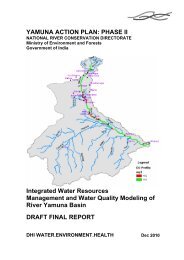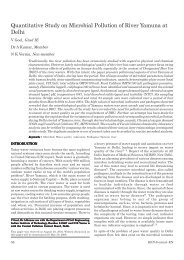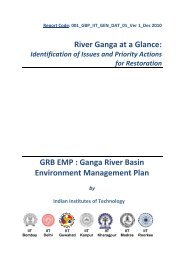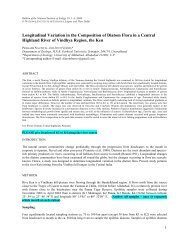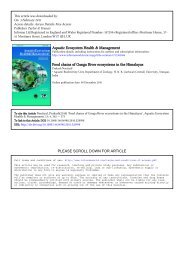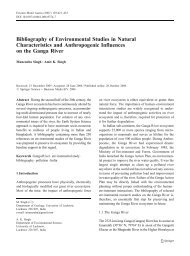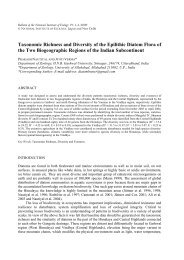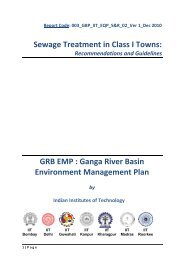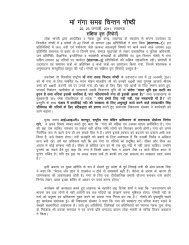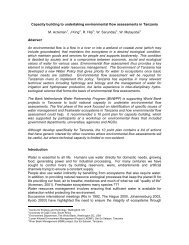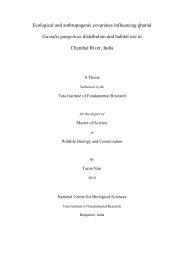Bibliography of Environmental Studies in Natural Characteristics ...
Bibliography of Environmental Studies in Natural Characteristics ...
Bibliography of Environmental Studies in Natural Characteristics ...
Create successful ePaper yourself
Turn your PDF publications into a flip-book with our unique Google optimized e-Paper software.
Environ Monit Assess (2007) 129:421–432<br />
DOI 10.1007/s10661-006-9374-7<br />
<strong>Bibliography</strong> <strong>of</strong> <strong>Environmental</strong> <strong>Studies</strong> <strong>in</strong> <strong>Natural</strong><br />
<strong>Characteristics</strong> and Anthropogenic Influences<br />
on the Ganga River<br />
Munendra S<strong>in</strong>gh & Amit K. S<strong>in</strong>gh<br />
Received: 23 December 2005 / Accepted: 28 June 2006 / Published onl<strong>in</strong>e: 28 October 2006<br />
# Spr<strong>in</strong>ger Science + Bus<strong>in</strong>ess Media B.V. 2006<br />
Abstract Dur<strong>in</strong>g the second half <strong>of</strong> the 20th century, the<br />
Ganga River ecosystem has been cont<strong>in</strong>uously altered by<br />
several ongo<strong>in</strong>g anthropogenic processes, accommodat<strong>in</strong>g<br />
multi-dimensional pressure due to <strong>in</strong>crease <strong>of</strong> nearly<br />
four-fold human population. For solution <strong>of</strong> any environmental<br />
issues <strong>of</strong> the river, the Earth System Science<br />
approach is required to have maximum socio-economic<br />
benefits to millions <strong>of</strong> people liv<strong>in</strong>g <strong>in</strong> Indian and<br />
Bangladesh. A bibliography conta<strong>in</strong><strong>in</strong>g more than 250<br />
references on environmental studies <strong>of</strong> the Ganga River<br />
was prepared to preserve its ecosystem by provid<strong>in</strong>g the<br />
basel<strong>in</strong>e support <strong>in</strong> this regard.<br />
Keywords Ganga River . environmental study .<br />
bibliography . pollution . India<br />
1 Introduction<br />
Anthropogenic processes have physically, chemically<br />
and biologically modified our great river ecosystems.<br />
Most <strong>of</strong> the time, the impact <strong>of</strong> anthropogenic force<br />
M. S<strong>in</strong>gh (*)<br />
Department <strong>of</strong> Geology, University <strong>of</strong> Lucknow,<br />
Lucknow 226 007, India<br />
e-mail: smunendra@gmail.com<br />
A. K. S<strong>in</strong>gh<br />
Department <strong>of</strong> <strong>Environmental</strong> Science,<br />
University <strong>of</strong> Lucknow,<br />
Lucknow 226 007, India<br />
on river ecosystem is either equivalent or grater than<br />
natural force. The importance <strong>of</strong> human–environment<br />
<strong>in</strong>teractions studies are widely recognised to understand<br />
the impact <strong>of</strong> anthropogenic activities on river<br />
ecosystem and is, therefore, required for protection <strong>of</strong><br />
it for further degradation.<br />
In Indian sub-cont<strong>in</strong>ent, the Ganga River ecosystem<br />
supports 25,000 or more species rang<strong>in</strong>g from microorganisms<br />
to mammals and serves as lifel<strong>in</strong>e for the<br />
population <strong>of</strong> over 500 million people. Dur<strong>in</strong>g Anthropocene,<br />
the Ganga River had experienced drastic<br />
degradation <strong>in</strong> its ecosystem. In February 1985, the<br />
M<strong>in</strong>istry <strong>of</strong> Environment and Forest, Government <strong>of</strong><br />
India launched the Ganga Action Plan, an environmental<br />
project to improve the river water quality. It was the<br />
largest s<strong>in</strong>gle attempt to clean up a polluted river<br />
anywhere <strong>in</strong> the world and has not achieved any success<br />
<strong>in</strong> terms <strong>of</strong> prevent<strong>in</strong>g pollution load and improvement<br />
<strong>in</strong> water quality <strong>of</strong> the river. Failure <strong>of</strong> the Ganga Action<br />
Plan may be directly l<strong>in</strong>ked with the environmental<br />
plann<strong>in</strong>g without proper understand<strong>in</strong>g <strong>of</strong> the human–<br />
environment <strong>in</strong>teractions. The bibliography <strong>of</strong> selected<br />
environmental research studies on the Ganga River is,<br />
therefore, an essentially first step for preserv<strong>in</strong>g and<br />
ma<strong>in</strong>ta<strong>in</strong><strong>in</strong>g the Ganga River ecosystem <strong>in</strong> future.<br />
1.1 The Ganga River<br />
The 2525-km-long Ganga (Ganges) River has its source at<br />
Gaumukh (30°36′ N; 79°04′ E) <strong>in</strong> snout <strong>of</strong> the Gangotri<br />
Glacier as the Bhagirathi River <strong>in</strong> the Higher Himalaya at
422 Environ Monit Assess (2007) 129:421–432<br />
an elevation <strong>of</strong> 3,800 m above mean sea level. The<br />
Bhagirathi River jo<strong>in</strong>s the Alaknanda River and the<br />
comb<strong>in</strong>ed stream is known as the Ganga River. After<br />
dra<strong>in</strong><strong>in</strong>g the Himalaya, the river enters <strong>in</strong>to the Ganga<br />
Pla<strong>in</strong> at Haridwar at an elevation <strong>of</strong> 300 m above mean sea<br />
level. Several tributaries <strong>of</strong> the river orig<strong>in</strong>ate from the<br />
Himalayan (the Yamuna, the Ramganga, the Ghaghara, the<br />
Gandak, and the Kosi Rivers etc.), from the Ganga Pla<strong>in</strong><br />
(the Gomati and the R<strong>in</strong>d Rivers etc.) and from Indian<br />
Craton (the Chambal, the Ken the Betwa and the Son<br />
Rivers) regions. After dra<strong>in</strong><strong>in</strong>g an area <strong>of</strong> about 1,086<br />
thousand km 2 , the river jo<strong>in</strong>s the Brahmaputra River and<br />
f<strong>in</strong>ally flows <strong>in</strong>to the Bay <strong>of</strong> Bengal (Figure 1).<br />
The Ganga River bas<strong>in</strong> has a humid subtropical<br />
climate characterized by three seasons namely monsoon,<br />
w<strong>in</strong>ter and summer. The bas<strong>in</strong> receives heavy<br />
ra<strong>in</strong>fall (usually 70–80% <strong>of</strong> total annual ra<strong>in</strong>fall)<br />
dur<strong>in</strong>g monsoon season, viz. <strong>in</strong> the months <strong>of</strong> July,<br />
August and September. Hydrology <strong>of</strong> the Ganga River<br />
shows maximum peak dur<strong>in</strong>g monsoon, and low<br />
dur<strong>in</strong>g w<strong>in</strong>ter and summer seasons. Annual discharge<br />
<strong>of</strong> the river is about 459,000 million m 3 at Farraka. The<br />
Figure 1 Location map <strong>of</strong> the Ganga River show<strong>in</strong>g important riverbank sites used <strong>in</strong> several research studies.
Environ Monit Assess (2007) 129:421–432 423<br />
river bas<strong>in</strong> susta<strong>in</strong>s about 500 million people hous<strong>in</strong>g <strong>in</strong><br />
its bas<strong>in</strong>. Nearly all sewage <strong>of</strong> the population directly or<br />
<strong>in</strong>directly goes <strong>in</strong>to the river, totall<strong>in</strong>g over 1.3 billion<br />
litres per day. Further 260 million litres <strong>of</strong> <strong>in</strong>dustrial<br />
wastes, run<strong>of</strong>f from 6 million tons <strong>of</strong> fertilizers and 900<br />
tons <strong>of</strong> pesticides used <strong>in</strong> agriculture with<strong>in</strong> the bas<strong>in</strong><br />
enters <strong>in</strong>to the river. The <strong>in</strong>creas<strong>in</strong>g population pressure<br />
along with unplanned urban growth, <strong>in</strong>adequate urban<br />
waste management, poor waste management by <strong>in</strong>dustries,<br />
<strong>in</strong>tensive use <strong>of</strong> chemical fertilisers, mass bath<strong>in</strong>g<br />
activities dur<strong>in</strong>g festivals etc. have led to severe<br />
environmental stress on the river ecosystem.<br />
1.1.1 Objective and data sources<br />
The present study was aimed to prepare a bibliography<br />
<strong>of</strong> environmental studies on the Ganga River (exclud<strong>in</strong>g<br />
the Ganga River tributaries). In early stage, the<br />
references were collected from our personal database<br />
followed by cross-referenc<strong>in</strong>g and several library<br />
searches. The Internet exploration with Sciencedirect<br />
and Scif<strong>in</strong>der etc. were also performed to fulfill<br />
demand <strong>of</strong> the bibliographic need. Most <strong>of</strong> the<br />
references were classified as scientific research articles<br />
published <strong>in</strong> national and <strong>in</strong>ternational journals.<br />
2 Discussion<br />
Results <strong>of</strong> science-based observations and measurements<br />
will certa<strong>in</strong>ly improve our understand<strong>in</strong>g for<br />
wise decision mak<strong>in</strong>g processes <strong>in</strong> the environmental<br />
plann<strong>in</strong>g <strong>of</strong> the Ganga River <strong>in</strong> future. The present<br />
bibliography is ma<strong>in</strong>ly concerned with analysis, survey<br />
and <strong>in</strong>vestigation <strong>in</strong> the environmental themes such as<br />
physico-chemical characteristics, hydro-geochemistry,<br />
organic geochemistry, faecal contam<strong>in</strong>ation, arsenic<br />
contam<strong>in</strong>ation, biomonitor<strong>in</strong>g etc. <strong>of</strong> the river and can<br />
be used as a reference study for government and nongovernment<br />
organisations. Table I. lists the references<br />
<strong>of</strong> research articles published after 1990.<br />
Acknowledgments The Department <strong>of</strong> Science and Technology,<br />
New Delhi has f<strong>in</strong>ancially supported this research through<br />
Fast Track Research Project Scheme (SR/FTP/ES-47/2000).<br />
The authors express their gratitude to Pr<strong>of</strong>. I. B. S<strong>in</strong>gh and Pr<strong>of</strong>.<br />
M. P. S<strong>in</strong>gh, Department <strong>of</strong> Geology, University <strong>of</strong> Lucknow,<br />
for their encouragement and support. We thank Ms. Pooja Goel<br />
for assistance <strong>in</strong> library search, Ms. Anju Saxena for helpful<br />
comments on the <strong>in</strong>itial draft and Mr. Pramod Joshi for mak<strong>in</strong>g<br />
diagram. F<strong>in</strong>ally, we should like to thank everyone who<br />
contributed to this bibliography. The editor-<strong>in</strong>-chief and an<br />
anonymous reviewer are thankful for their comments that<br />
improve the quality <strong>of</strong> presentation.<br />
Table I List <strong>of</strong> recent environmental studies (from 1990 onwards) published <strong>in</strong> <strong>in</strong>ternational journals on the Ganga River<br />
Properties References<br />
Physical Ahmad and Hussa<strong>in</strong>, 2001;Alley,1994; Asthanaet al., 1999; Bhargava, 1992; Bhatt and Saklani, 1996;Hamneret al., 2006;<br />
Kamal et al., 1998; Kumaret al., 2003; Monirul Qudar Mirza et al., 1998, 2001; Mukherjee et al., 1993; Peierlset al., 1991;<br />
Semwal and Akolkar, 2006, S<strong>in</strong>ghet al., 1999a, b, c; S<strong>in</strong>haet al., 1991; Tomal<strong>in</strong> and Hollick, 2002; Tripathi et al., 1991;<br />
Umar et al., 2000, 2001.<br />
Chemical Inorganic:<br />
Acharyya et al., 1999, 2005; Balakrishna et al., 2001; Barua, et al., 1994; Bhatt and Saklani, 1996; Bhattacharya and<br />
Sarkar et al. 1996; Carroll et al., 1993; Chakrapani et al., 2002; Chakrapani 2005; Chattopadhya et al. 1995, 1996;<br />
Chowdhury et al., 1999; Dalai et al., 2002a, b; Dutta and Subramanian, 1998; Garg et al., 1992; Islam et al., 2004; Ja<strong>in</strong>,<br />
2001, 2002; Kannan et al., 1993, 1997; Khan and Abbasi 2004; Khwaja et al., 2001; Lahiri 2002; Modak et al., 1990,<br />
1992; Nickson et al., 1993; Pal et al., 2002; Pandey and Sundaram, 2002; Pathak et al., 1992; Peierls et al., 1991;<br />
Ramesh and Sar<strong>in</strong>, 1992; Ramkrishna et al., 2001; Sar<strong>in</strong> et al., 1990; Sar<strong>in</strong>, 2001; Sarkar et al., 2002, 2003; Sengupta<br />
et al., 2004; Sharma et al., 1992; Sharma et al., 2003; S<strong>in</strong>gh and Hasna<strong>in</strong>, 1998; S<strong>in</strong>gh and Mahaver, 1997; S<strong>in</strong>gh et al.,<br />
1999; S<strong>in</strong>gh et al., 2002; S<strong>in</strong>gh et al., 2004; Somyajulu, 1994; Somyajulu et al., 2002; Subramanian, 1993.<br />
Organic:<br />
Agnihotri et al., 1994, 1996; Ahmad et al., 1996; Ansari, et al., 1998, 1999, 2000; Bhattacharya et al., 2003; Gupta and<br />
Raghubansi, 2002; Guzzela et al., 2005; Halder et al., 1990; Kumari et al., 2002; Mohapatra et al., 1995; Nayak et al.,<br />
1995; Sankaramakrishnan, et al., 2005.<br />
Biological Baghel et al., 2005; Bhanumatiet al., 2003; Bilgrami and Kumar, 1998; Deet al., 1991; GuptaandSharma,2005; Hans et<br />
al., 1999; Islamet al., 2004; Joshi et al., 1995; Khan and Abbasi, 2004; Mallick and Kuda-Baksh, 2003; Mannaet al., 2004;<br />
Rao 2001;Rehanaet al., 1995, 1996; Senthilkumar et al., 1999; S<strong>in</strong>gh and S<strong>in</strong>gh, 1999;S<strong>in</strong>ha,1997a, b, c; Tare et al., 2003.
424 Environ Monit Assess (2007) 129:421–432<br />
<strong>Bibliography</strong><br />
Abbas, N., & Subramanian, V. (1984). Erosion and sediment<br />
transport <strong>in</strong> the Ganges River Bas<strong>in</strong>, India. Journal <strong>of</strong><br />
Hydrology, 69, 173–182.<br />
Acharyya, S. K. (2005). Arsenic levels <strong>in</strong> groundwater from<br />
Quaternary alluvium <strong>in</strong> Ganga Pla<strong>in</strong> and the Bengal Bas<strong>in</strong>,<br />
Indian subcont<strong>in</strong>ent: Insights <strong>in</strong>to <strong>in</strong>fluence <strong>of</strong> stratigraphy.<br />
Gondwana Research, 8, 55–66.<br />
Acharyya, S. K., Chakroborty, P., Lahiri, S., Raymahashay,<br />
B. C., Guha, S., & Bhowmik, A. (1999). Arsenic<br />
poison<strong>in</strong>g <strong>in</strong> the Ganges Delta. Nature, 401, 545.<br />
Adel, M. M. (2001). Effects on water resources from upstream<br />
water diversion <strong>in</strong> the Ganges Bas<strong>in</strong>. Journal <strong>of</strong> <strong>Environmental</strong><br />
Quality, 30, 356–368.<br />
Agarwal, D. K., Gaur, S. D., Tiwari, I. C., Narayanswami, N.,<br />
& Marwah, S. M. (1976). Ind. J. Environ. Health Physicochemical<br />
characterstics <strong>of</strong> Ganges water at Varanasi, India.<br />
Indian Journal <strong>of</strong> <strong>Environmental</strong> Health, 18, 201–206.<br />
Agnihotri, N. P., Gajbhiye, V. T., Kumar, M., & Mohapatra,<br />
S. P. (1994). Organochlor<strong>in</strong>e pesticide residues <strong>in</strong> the<br />
Ganges River Water near Farrukhabad, India. <strong>Environmental</strong><br />
Monitor<strong>in</strong>g and Assessment, 30, 105–112.<br />
Agnihotri, N. P., Kulshrestha, G., Gajbhiye, V. T., Mahapatra,<br />
S. P., & S<strong>in</strong>gh, S. B. (1996). Organochlor<strong>in</strong>e pesticide<br />
residues <strong>in</strong> the Ganges River. <strong>Environmental</strong> Monitor<strong>in</strong>g<br />
and Assessment, 40, 279–288.<br />
Ahmad, S., Ajmal, M., & Nomani, A. A. (1996). Organochlor<strong>in</strong>es<br />
and polycyclic aromatic hydrocarbons <strong>in</strong> the<br />
sediments <strong>of</strong> Ganges River, India. Bullet<strong>in</strong> <strong>of</strong> <strong>Environmental</strong><br />
Contam<strong>in</strong>ation and Toxicology, 57, 794–802.<br />
Ahmad, S., & Hussa<strong>in</strong>, S. I. (2001). Snow and stream-water<br />
chemistry <strong>of</strong> the Ganga Head water Bas<strong>in</strong>, Garhwal Himalaya,<br />
India. Hydrological Sciences Journal, 46, 103–111.<br />
Ajmal, M., Khan, M. A., & Nomani, A. A. (1987). Monitor<strong>in</strong>g<br />
<strong>of</strong> heavy metals <strong>in</strong> the water and sediments <strong>of</strong> the Ganga<br />
River, India. Water Science and Technology, 19, 107–117.<br />
Ajmal, M., Nomani, A. A., & Khan, M. A. (1983). Pollution <strong>in</strong><br />
the Ganges River, India. Water Science and Technology,<br />
16, 347–358.<br />
Alley, K. D. (1994). Ganga and Gandagi: Interpretation <strong>of</strong><br />
pollution and waste <strong>in</strong> Benaras. Ethnology, 33, 127–145.<br />
Alley, K. D. (2002). On the Banks <strong>of</strong> the Ganga: When<br />
wastewater meets a sacred river. University <strong>of</strong> Michigan<br />
Press, pp. 312.<br />
Anand, P., & Agarwal, P. (2000). Impact <strong>of</strong> action plan schemes<br />
and Barrage Project on river Ganga <strong>in</strong> Kanpur. B. Tech.<br />
Thesis. Department <strong>of</strong> Civil Eng<strong>in</strong>eer<strong>in</strong>g, Indian Institute<br />
<strong>of</strong> Technology, Kanpur.<br />
Ansari, A. A., S<strong>in</strong>gh, I. B., & Tobschall, H. J. (1998).<br />
Organot<strong>in</strong> compounds <strong>in</strong> surface and pore waters <strong>of</strong><br />
Ganga Pla<strong>in</strong> <strong>in</strong> the Kanpur–Unnao <strong>in</strong>dustrial region, India.<br />
Science <strong>of</strong> the Total Environment, 223, 157–166.<br />
Ansari, A. A., S<strong>in</strong>gh, I. B., & Tobschall, H. J. (1999). Status <strong>of</strong><br />
anthropogenically <strong>in</strong>duced metal pollution <strong>in</strong> Kanpur–<br />
Unnao <strong>in</strong>dustrial region <strong>of</strong> the Ganga Pla<strong>in</strong>, India.<br />
<strong>Environmental</strong> Geology, 38, 25–33.<br />
Ansari, A. A., S<strong>in</strong>gh, I. B., & Tobschall, H. J. (2000). Role <strong>of</strong><br />
monsoon ra<strong>in</strong> on concentrations and dispersion patterns <strong>of</strong><br />
metal pollutants <strong>in</strong> sediments and soils <strong>of</strong> the Ganga Pla<strong>in</strong>,<br />
India. <strong>Environmental</strong> Geology, 39, 221–237.<br />
Asthana, B. N., Lal, J. R., & Sharma, J. K. (1999). Barrage on<br />
Ganga at Kanpur. Water and Energy International, 56, 31–41.<br />
Baghel, V. S., Gopal, K., Dwivedi, S., & Tripathi, R. D. (2005).<br />
Bacterial <strong>in</strong>dicators <strong>of</strong> faecal contam<strong>in</strong>ation <strong>of</strong> the Gangetic<br />
river system right at its source. Ecological Indicators,<br />
5, 49–56.<br />
Balakrishna, K., Shankar, R., Sar<strong>in</strong>, M. M., & Manjunatha, B. R.<br />
(2001). Distribution <strong>of</strong> U–Th nuclides <strong>in</strong> the river<strong>in</strong>e and<br />
coastal environmental <strong>of</strong> the tropical southwest coast <strong>of</strong><br />
India. Journal <strong>of</strong> <strong>Environmental</strong> Radioactivity, 57, 21–33.<br />
Banerjee, B. N. (1989). Can the Ganga be cleaned? (pp. 197).<br />
New Delhi: B. R. Publish<strong>in</strong>g Corporation.<br />
Barua, D. K., Kushel, S. A., Miller, R. L., & Moore, W. S.<br />
(1994). Suspended sediment distribution and residual<br />
transport <strong>in</strong> the coastal ocean <strong>of</strong>f the Ganges–Brahmaputra<br />
River mouth. Mar<strong>in</strong>e Geology, 120, 41–61.<br />
Basu, A. K., Ghosh, B. N., & Pal, R. N. (1970). Comparison <strong>of</strong><br />
polluted Hooghly estuary with the unpolluted Maltah<br />
estuary, India. Journal <strong>of</strong> Water Pollution Research, 42,<br />
1771–1781.<br />
Basu, M., & Mitra, A. K. (2002). <strong>Studies</strong> on the pollution <strong>of</strong><br />
river Damodar at Burdwan with special reference to<br />
metals, COD, and pH. Nature, <strong>Environmental</strong> Pollution<br />
Technology, 1, 397–399.<br />
Bhanumati, R., Sabeena, F., Isac, S. R., Shukla, B. N., &<br />
S<strong>in</strong>gh, D. V. (2003). Molecular characterization <strong>of</strong> Vibrio<br />
cholerae O139 Bengal isolated from water and the aquatic<br />
plant Eichhornia crassipes <strong>in</strong> the River Ganga, Varanasi,<br />
India. Applied and <strong>Environmental</strong> Microbiology, 69, 2389–<br />
2394.<br />
Bhargava, D. S. (1977). Water quality <strong>in</strong> three typical rivers<br />
<strong>in</strong> U. P.–Ganga, Yamuna and Kali. PhD Thesis.<br />
Department <strong>of</strong> Civil Eng<strong>in</strong>eer<strong>in</strong>g, Indian Institute <strong>of</strong> Technology,<br />
Kanpur.<br />
Bhargava, D. S. (1983). Use <strong>of</strong> a water quality <strong>in</strong>dex for river<br />
classification and zon<strong>in</strong>g <strong>of</strong> the Ganga river. <strong>Environmental</strong><br />
Pollution (Series B), 6, 51–67.<br />
Bhargava, D. S. (1987). Nature and the Ganga. <strong>Environmental</strong><br />
Conservation, 14, 307–318.<br />
Bhargava, D. S. (1992). Why the Ganga (Ganges) could not be<br />
cleaned. <strong>Environmental</strong> Conservation, 19, 170–172.<br />
Bhargava, D. S. (1997). Water quality <strong>of</strong> the River Ganga at<br />
Varanasi. Journal <strong>of</strong> the Institution <strong>of</strong> Eng<strong>in</strong>eers, India, 78,<br />
1–4.<br />
Bhatt, K. P., & Saklani, S. (1996). Hydrogeochemistry <strong>of</strong> the<br />
upper Ganges River, India. Journal <strong>of</strong> the Geological<br />
Society <strong>of</strong> India, 48, 171–182.<br />
Bhattacharya, B., & Sarkar, S. (1996). Total mercury content <strong>in</strong><br />
mar<strong>in</strong>e organism <strong>of</strong> the Hooghly estuary, West Bengal.<br />
Chemosphere, 33, 147–158.<br />
Bhattacharya, B., Sarkar, S., & Maji, P. K. (1994). Bioaccumulation<br />
<strong>of</strong> heavy metals <strong>in</strong> flora and fauna <strong>of</strong> Hooghly<br />
estuary, east coast <strong>of</strong> India. Toxicology and <strong>Environmental</strong><br />
Chemistry, 42, 123–130.<br />
Bhattachrya, B., Sarkar, S. K., & Mukherjee, N. (2003).<br />
Organochlor<strong>in</strong>e pesticide residue <strong>in</strong> sediments <strong>of</strong> a tropical<br />
mangrove estuary. Environment International, 29, 587–592.<br />
Bhowmick, B. N., & S<strong>in</strong>gh A. K. (1985). Phytoplankton<br />
population <strong>in</strong> relation to physico-chemical factors <strong>of</strong><br />
river Ganga at Patna. Indian Journal <strong>of</strong> Ecology, 13,<br />
138–145.
Environ Monit Assess (2007) 129:421–432 425<br />
Bilgrami, K. S. (1991a). Biological pr<strong>of</strong>ile <strong>of</strong> the Ganga<br />
zooplankton fish, birds, and other micro fauna. In C. R.<br />
Krishnamurti, K. S. Bilgrami, T. M. Das, R. P. Mathur<br />
(Eds.), The Ganga Scientific Study (pp. 81–94). New<br />
Delhi: Northern Book Center.<br />
Bilgrami, K. S. (1991b). Biological pr<strong>of</strong>ile <strong>of</strong> the Ganga: Bacteria<br />
and Bacteriophages. In C. R. Krishnamurti, T. S. Bilgrami,<br />
T. M. Das, & R. P Mathur (Eds.), The Ganga: A Scientific<br />
study (pp. 72–77). New Delhi: Northern Book Center.<br />
Bilgrami, K. S. (1991c). Biological pr<strong>of</strong>ile <strong>of</strong> the Ganga:<br />
Fungi. In C. R. Krishnamurti, T. S. Bilgrami, T. M. Das,<br />
& R. P. Mathur (Eds.), The Ganga: A Scientific study (pp.<br />
67–71). New Delhi: Northern Book Center.<br />
Bilgrami, K. S. (1991d). Biomonitor<strong>in</strong>g <strong>of</strong> water quality <strong>of</strong> the<br />
Ganga. In C. R. Krishnamurti, T. S. Bilgrami, T. M. Das,<br />
& R. P. Mathur (Eds.), The Ganga: A Scientific study (pp.<br />
101–106). New Delhi: Northern Book Center.<br />
Bilgrami, K. S. (1991e). Macrophytic, Marg<strong>in</strong>al and Riparian<br />
vegetation <strong>of</strong> the Ganga. In C. R. Krishnamurti, T. S.<br />
Bilgrami, T. M. Das, & R. P. Mathur (Eds.), The Ganga: A<br />
Scientific study (pp. 107–116). New Delhi: Northern Book<br />
Center.<br />
Bilgrami, K. S. (1991f). Possible food-cha<strong>in</strong> operative <strong>in</strong> the<br />
Ganga. In C. R. Krishnamurti, T. S. Bilgrami, T. M. Das,<br />
& R. P. Mathur (Eds.), The Ganga: A Scientific study (pp.<br />
95–98). New Delhi: Northern Book Center.<br />
Bilgrami, K. S., & Datta Munshi, J. S. (1985). Ecology <strong>of</strong><br />
river Ganga, Impacts <strong>of</strong> Human activities and conservation<br />
<strong>of</strong> aquatic biota (Patna to Farakka). F<strong>in</strong>al Technical<br />
report <strong>of</strong> MAB Project, Bhagalpur University, Bhagalpur.<br />
Bilgrami, K. S., Dattamunshi, J. S., Siddiqui, E. N., & S<strong>in</strong>gh,<br />
N. K. (1979). Primary productivity <strong>of</strong> phytoplankton <strong>of</strong><br />
the river Ganges. Biological Bullet<strong>in</strong>, 1, 39–42.<br />
Bilgrami, K. S., & Dutta Munshi, J. S. (1979). Limnology<br />
survey and impact <strong>of</strong> human activities on the river Ganga<br />
(Barauni to Farakka). Bhagalpur: Allied.<br />
Bilgrami, K. S., & Kumar, S. (1998). Bacterial contam<strong>in</strong>ation<br />
<strong>in</strong> water <strong>of</strong> the River Ganga and its risk to human health.<br />
International Journal <strong>of</strong> <strong>Environmental</strong> Health Research,<br />
8, 5–13.<br />
Biswas, B. K., & Konar, S. K. (2000). Impact <strong>of</strong> waste<br />
disposal on plankton abundance and diversity <strong>in</strong> the<br />
River Ganga at Hathidah, Bihar. Pollution Research, 19,<br />
633–640.<br />
Carroll, J., Falkner, K. K., Brown, E. T., & Moore, W. S.<br />
(1993). The role <strong>of</strong> the Ganges–Brahmaputra mix<strong>in</strong>g zone.<br />
Geochimica et Cosmochimica Acta, 58, 4987–4995.<br />
Central Pollution Control Board (1991). Status and trend <strong>of</strong><br />
water quality <strong>of</strong> river Ganga (1985–1989). Monitor<strong>in</strong>g <strong>of</strong><br />
Indian National Aquatic Resources Series (MINARS),<br />
Delhi.<br />
Chakraborthy, D., Biswas, B. K., & Konar, S. K. (1999).<br />
Habitat degradation and related <strong>in</strong>vertebrate macrobenthic<br />
population dynamics <strong>in</strong> the river Ganga. Environment and<br />
Ecology, 17, 149–153.<br />
Chakrapani, G. J. (2005). Major and trace element geochemistry<br />
<strong>in</strong> upper Ganga River <strong>in</strong> the Himalayas, India.<br />
<strong>Environmental</strong> Geology, 48, 189–201.<br />
Chakrapani, G. J., Gaillardet, J., Dupre, B., & Allegre, C. J.<br />
(2002). Osmium isotopic compositions <strong>in</strong> Ganga river<br />
sediments. Current Science, 83, 1253–1255.<br />
Chaphekar,S.B.,&Mhatre,G.N.(1986).Human Impact on<br />
Ganga river ecosystem: An assessment. New Delhi: Concept.<br />
Chattopadhya, M., & Lahiri, S. C. (1996). <strong>Studies</strong> on the metals<br />
concentrations <strong>of</strong> bottom sediments <strong>of</strong> the River Ganga.<br />
Journal <strong>of</strong> the Indian Chemical Society, 73, 592–595.<br />
Chattopadhya, M., Mukherjee D., Bhattachraya, S. K., &<br />
Lahiri, S. C. (1995). <strong>Studies</strong> on soil parameters <strong>of</strong><br />
sediments from the river Ganga phosphorous mobilization,<br />
<strong>in</strong>teractions with sediment and the phosphorous cycle.<br />
<strong>Environmental</strong>ist, 15, 211–219.<br />
Chattopadhya, S. N., Routh, T., & Sharma, V. P. (1984). A<br />
short-term study on the pollutional status <strong>of</strong> River Ganga<br />
<strong>in</strong> Kanpur region. Indian Journal <strong>of</strong> <strong>Environmental</strong><br />
Health, 26, 244–257.<br />
Chattopadhya, D. N., Saha, M. K., & Konar, S. K. (1987). Some<br />
bio-ecological studies <strong>of</strong> the river Ganga <strong>in</strong> relation to water<br />
pollution. Environment and Ecology, 15, 494–500.<br />
Chaturvedi, S. K., Kumar, D., & S<strong>in</strong>gh, R. V. (2003). Study on<br />
some physico-chemical characteristics <strong>of</strong> flow<strong>in</strong>g water <strong>of</strong><br />
Ganges River at Hardwar. Research Journal <strong>of</strong> Chemistry<br />
and Environment, 7, 78–79.<br />
Chaudhaury, R. (2001). Factor analysis <strong>in</strong> <strong>in</strong>terpretation <strong>of</strong><br />
Ganga river water quality. Indian Journal <strong>of</strong> <strong>Environmental</strong><br />
Protection, 21, 403–408.<br />
Chaudhuri, M., & Dutta, A. (1980). Mercury levels <strong>in</strong> Ganga<br />
water and sediments near Kanpur. Journal <strong>of</strong> the Institution<br />
<strong>of</strong> Eng<strong>in</strong>eers, India, 48, 61.<br />
Chaudhury, U. K., & Ojha, C. S. P. (1985). <strong>Environmental</strong><br />
impact <strong>of</strong> the river Ganga at Varanasi. Proceed<strong>in</strong>gs <strong>of</strong> the<br />
<strong>Environmental</strong> Impact Assessment <strong>of</strong> Water Resources<br />
Project (pp. 760–771). India: University <strong>of</strong> Roorkee.<br />
Chopra, A. K., & Patrick, N. J. (2000). Effects <strong>of</strong> domestic<br />
sewage <strong>of</strong> self-purification <strong>of</strong> Ganga water at Rishikesh II<br />
microbiological parameters. <strong>Environmental</strong> Issues and<br />
Management, 6, 81–86.<br />
Chowdhury, T. R., Basu, G. K., Mandal, B. K., Biswas, B. K.,<br />
Samanta, G., Chowdhury, U. K., et al. (1999). Arsenic<br />
poison<strong>in</strong>g <strong>in</strong> the Ganges delta. Nature, 401, 545–546.<br />
Dalai, T. K., Krishnaswami, S., & Sar<strong>in</strong>, M. M. (2002a). Major<br />
ion chemistry <strong>in</strong> the headwaters <strong>of</strong> the Yamuna river<br />
system: Chemical weather<strong>in</strong>g, its temperature dependence<br />
and CO2 consumption <strong>in</strong> the Himalaya. Geochimica et<br />
Cosmochimica Acta, 66, 3397–3416.<br />
Dalai, T. K., S<strong>in</strong>gh, S. K., Trivedi, J. R., & Krishnaswami, S.<br />
(2002b). Dissolved rhenium <strong>in</strong> the Yamuna river (India)<br />
system and the Ganga <strong>in</strong> the Himalaya: Role <strong>of</strong> black<br />
shale weather<strong>in</strong>g on the budgets <strong>of</strong> Re, Os, and U <strong>in</strong> rivers<br />
and CO 2 <strong>in</strong> the atmosphere. Geochimica et Cosmochimica<br />
Acta, 66, 29–43.<br />
Das, T. M. (1991). <strong>Environmental</strong> awareness <strong>of</strong> problems related<br />
to the Ganga. In C. R. Krishnamurti, T. S. Bilgrami, T. M.<br />
Das, & R. P. Mathur (Eds.), The Ganga: A Scientific study<br />
(pp. 205–206). New Delhi: Northern Book Center.<br />
Das, A. K. (2002). Limno-chemistry and productivity <strong>of</strong> upper<br />
Ganga complex. Pollution Research, 21, 157–168.<br />
Dasgupta, S. P. (1984). Bas<strong>in</strong> sub bas<strong>in</strong> <strong>in</strong>ventory <strong>of</strong> water<br />
pollution. The Ganga Bas<strong>in</strong>, Part II. New Delhi, India:<br />
Central Board for Preventation and Control <strong>of</strong> Water<br />
Pollution.<br />
Datta, N. C. (1991). Assessment <strong>of</strong> pollution load on the Ganga<br />
<strong>in</strong> the stretch Bally to Bandel. In C. R. Krishnamurti, T. S.
426 Environ Monit Assess (2007) 129:421–432<br />
Bilgrami, T. M. Das, & R. P. Mathur (Eds.), The Ganga: A<br />
Scientific study (pp. 147–155). New Delhi: Northern Book<br />
Center.<br />
De, T. K., Gosh, S. K., Jana, T. K., & Choudhury, A. (1991).<br />
Phytoplankton bloom <strong>in</strong> the Hoogly estuary, India. Indian<br />
Journal <strong>of</strong> Mar<strong>in</strong>e Sciences, 20, 134–137.<br />
Dutta, D. K., & Subramanian, V. (1998). Distribution and<br />
fractionation <strong>of</strong> heavy metals <strong>in</strong> the surface sediments <strong>of</strong><br />
Ganges–Bramaputra–Meghna river system <strong>in</strong> the Bengal<br />
bas<strong>in</strong>. <strong>Environmental</strong> Geology, 36, 93–101.<br />
Dwivedi, A. (1991). <strong>Studies</strong> on sediments <strong>of</strong> river Ganga with<br />
reference to its pollution. PhD Thesis. University <strong>of</strong><br />
Kanpur, Kanpur.<br />
Dwivedi, S., & Tiwari, I. C. (1997). A study on heavy metals <strong>in</strong> the<br />
Ganga water at Varanasi. Pollution Research, 16, 265–270.<br />
Dwivedi, S., Tiwari, I. C., & Bhargava, D. S. (2000). Classification<br />
<strong>of</strong> water quality <strong>of</strong> River Ganga at Varanasi. Indian<br />
Journal <strong>of</strong> <strong>Environmental</strong> Protection, 20, 688–697.<br />
Gajbhiye, V. T., Kalra, N., Mohapatra, S. P., & Agnihotri, N. P.<br />
(1996). Non-po<strong>in</strong>t pollution <strong>of</strong> Ganga river with pesticides:<br />
A quantitative approach. Journal <strong>of</strong> <strong>Environmental</strong><br />
Systems, 24, 95–110.<br />
Garg, N., Mathur, N., Modak, D. P., S<strong>in</strong>gh, K. P., Murthy, R.<br />
C., Ahmed, S., et al. (1992). Trace metals trend analysis <strong>in</strong><br />
river Ganges at Kanpur. Environment International, 18,<br />
297–305.<br />
Gaur, R. K., Khan, A. A., Alam, A., & Alam, A. (2000).<br />
Bacteriological quality <strong>of</strong> River Ganga from Narora to<br />
Kannauj: A comparative study. Indian Journal <strong>of</strong> <strong>Environmental</strong><br />
Protection, 20, 165–170.<br />
Ghatak, D. B., & Konar, S. K. (1994). Field survey on the<br />
effect <strong>of</strong> population by various <strong>in</strong>dustrial effluents on<br />
Hooghly estuary at Haldia, West Bengal. Environment and<br />
Ecology, 12, 128–132.<br />
Gopal, B. (2001). Holy Ganga and the Mighty Amazon.<br />
Amazoniana, 16, 337–348.<br />
Gopal, B., & Zutshi, D. P. (2001). Aquatic ecosystem health:<br />
An Indian perspective. Verhandlungen-Internationale Vere<strong>in</strong>igung<br />
fuer Theoretische und Angewandate Limnologie,<br />
27, 2336–2339.<br />
Gopalkrishna, V., Ray, P., & Ghosh, B. B. (1973). Present<br />
status <strong>of</strong> pollution <strong>of</strong> the Hooghly estuary with the special<br />
reference to adverse effects observed on fisheries resources.<br />
Proceed<strong>in</strong>gs <strong>of</strong> the Symposium on <strong>Environmental</strong><br />
Pollution. Nagpur 1–8.<br />
Gosh, A. K. (1991). The Ganga: A pr<strong>of</strong>ile and biological resources.<br />
In M. S. Jairajpuri (Ed.), Faunal resources <strong>of</strong> Ganga, partI<br />
(pp. 1–12). Calcutta: Zoological Survey <strong>of</strong> India.<br />
Gupta, S. (2000). A novel approach for assessment <strong>of</strong> action plan<br />
schemes on water quality <strong>of</strong> river Ganga. M. Tech. Thesis.<br />
<strong>Environmental</strong> Eng<strong>in</strong>eer<strong>in</strong>g and Management Programme,<br />
Indian Institute <strong>of</strong> Technology, Kanpur, India.<br />
Gupta, A. K., & Raghubansi, A. K. (2002). Comparative study<br />
<strong>of</strong> enrichment <strong>of</strong> nutrients and heavy metals <strong>in</strong> river waters<br />
<strong>of</strong> Ghaghara and Ganga due to anthropogenic pressures.<br />
Pollution Research, 21, 261–263.<br />
Gupta, K., & Sharma, A. (2005). Macro<strong>in</strong>vertebrates as<br />
<strong>in</strong>dicators <strong>of</strong> pollution. Journal <strong>of</strong> <strong>Environmental</strong> Biology,<br />
26, 205–211.<br />
Guzzella, L., Roscioli, C., Vigano, L., Saha, M., Sarkar, S. K.,<br />
& Bhattacharya, A. (2005). Evaluation <strong>of</strong> the concentra-<br />
tion <strong>of</strong> HCH, DDT, HCB, PCB, and PAH <strong>in</strong> the sediments<br />
along the lower stretch <strong>of</strong> Hugli estuary. Environment<br />
International, 31, 523–534.<br />
Haldar, P., Raha, P., Bhattacharya, P., Choudhury, A., &<br />
Adityachaudhury, N. (1989). <strong>Studies</strong> on the residues <strong>of</strong><br />
DDT and endosulfan occurr<strong>in</strong>g <strong>in</strong> Ganga water. Indian<br />
Journal <strong>of</strong> <strong>Environmental</strong> Health, 31, 156–161.<br />
Halder, P., Kole, R. K., Bhattacharya, A., Chowdhary, A., &<br />
Adityachaudhury, N. (1990). <strong>Studies</strong> on the residues <strong>of</strong><br />
BHC isomers (α, β, γ, and δ) occurr<strong>in</strong>g <strong>in</strong> Ganga water.<br />
Pollution Research, 9, 51–56.<br />
Hamner, S., Tripathi, A., Misra, R. K., Bauskill, N., Broadway,<br />
S. C., Pyle, B. H., & Ford, T. E. (2006). The role <strong>of</strong> water<br />
use patterns and sewage pollution <strong>in</strong> <strong>in</strong>cidence <strong>of</strong> water<br />
borne/enteric disease along the Ganges River <strong>in</strong> Varanasi,<br />
India. International Journal <strong>of</strong> <strong>Environmental</strong> Health<br />
Research, 16, 113–132.<br />
Handa, B. K. (1972). Geochemistry <strong>of</strong> Ganges river water,<br />
India. Geohydrol, 8, 71–78.<br />
Hans, R. K., Farooq, M., Babu, G. S., Shrivastava, S. P., Joshi,<br />
P. C., & Viswanathan, P. N. (1999). Agricultural produce<br />
<strong>in</strong> dry bed <strong>of</strong> the river Ganga <strong>in</strong> Kanpur, India, a new<br />
source <strong>of</strong> pesticide contam<strong>in</strong>ation <strong>in</strong> human diets. Food<br />
and Chemical Toxicology, 37, 847–852.<br />
Hussa<strong>in</strong>, F. (1997). Remedial measures proposed to safeguard<br />
the Ganga water quality. Journal <strong>of</strong> the Institution <strong>of</strong><br />
Eng<strong>in</strong>eers, India, 78, 5–8.<br />
Islam, F. S., Gault, A. G., Boothman, C., Polya, D. A.,<br />
Charnock, J. M., Chatterjee, D., & Lloyd, J. R. (2004).<br />
Role <strong>of</strong> metal reduc<strong>in</strong>g bacteria <strong>in</strong> arsenic releases from<br />
Bengal delta sediments. Nature, 430, 68–71.<br />
Ittekkot, V. (1988). Global trends <strong>in</strong> the nature <strong>of</strong> organic matter<br />
<strong>in</strong> river suspension. Nature, 332, 436–438.<br />
Ittekkot, V., Safiullah, S., Myeke, B., & Seifert, R. (1985). Seasonal<br />
variability and geochemical significance <strong>of</strong> organic matter <strong>in</strong><br />
the River Ganges, Bangladesh. Nature, 317, 800–802.<br />
Jabber, S. M. A., Khan, Y. S. A., & Rahman, S. (2001). Levels<br />
<strong>of</strong> Organochlor<strong>in</strong>e Pesticide Residues <strong>in</strong> Some Organs <strong>of</strong><br />
the Ganges Perch, Lates calcarifer, from the Ganges–<br />
Brahmaputra–Meghna Estuary, Bangladesh. Mar<strong>in</strong>e Pollution<br />
Bullet<strong>in</strong>, 42, 1291–1296.<br />
Ja<strong>in</strong>, C. K. (2000). Pollution status <strong>of</strong> river Ganga. Indian<br />
Journal <strong>of</strong> <strong>Environmental</strong> Protection, 20, 471–473.<br />
Ja<strong>in</strong>, C. K. (2001). Adsorption <strong>of</strong> z<strong>in</strong>c on to bed sediments <strong>of</strong><br />
the River Ganga: Adsorption models and k<strong>in</strong>etics. Hydrological<br />
Sciences Journal, 46, 419–433.<br />
Ja<strong>in</strong>, C. K. (2002). A hydro-chemical study <strong>of</strong> mounta<strong>in</strong>ous<br />
watershed: The Ganga, India. Water Research, 36, 1262–1274.<br />
Jayaraman, K. S. (1985a). Ganges pollution: Cleans<strong>in</strong>g river<br />
due for clean<strong>in</strong>g. Nature, 315, 363.<br />
Jayaraman, K. S. (1985b). Skull-trade ban. Nature, 317, 567.<br />
Jayaraman, K. S. (1987). Indian health planners shun <strong>in</strong>secticides<br />
<strong>in</strong> disease control. Nature, 329, 572.<br />
Jayaraman, K. S. (1988). India modernizes crematoria. Nature,<br />
331, 292.<br />
Jayaraman, K. S. (1996). Ban tourists call to save glacier<br />
sources <strong>of</strong> the Ganges. Nature, 384, 602.<br />
Jena, B., Sudarshana, R., & Chaudhuary, S. B. (2003). <strong>Studies</strong><br />
on water quality parameters around Sagar Island, Sunderbans.<br />
Nature, <strong>Environmental</strong> Pollution Technology, 2,<br />
329–332.
Environ Monit Assess (2007) 129:421–432 427<br />
Jh<strong>in</strong>gran, A. G. (1988). Aquatic pollution with the special<br />
reference to the Ganga river system. Comment—National<br />
Symposium on <strong>Environmental</strong> impacts on Animals and<br />
Aquaculture (pp. 6–19). Kalyani: Department <strong>of</strong> Zoology,<br />
University <strong>of</strong> Kalyani.<br />
Jh<strong>in</strong>gran, A. G. (1989). Impact <strong>of</strong> environmental perturbations<br />
on the fisheries ecology <strong>of</strong> river Ganga. Central Inland<br />
Capture Fish. Res. Inst. Barrackpore: Bullet<strong>in</strong> No. 26.<br />
Jh<strong>in</strong>gran, A. G., Ahmad, S. H., & S<strong>in</strong>gh, A. K. (1989).<br />
Application <strong>of</strong> Shannon–Wiener <strong>in</strong>dex as a measure <strong>of</strong><br />
pollution <strong>of</strong> river Ganga at Patna, Bihar, India. Current<br />
Science, 58, 717–720.<br />
Joshi, H. C., & Gosh, B. B. (1982). <strong>Studies</strong> on the<br />
distribution <strong>of</strong> Organochlor<strong>in</strong>e pesticides residues <strong>in</strong><br />
Hooghly estuary. First Nat. Environ. Conference. ICAR,<br />
New Delhi, p. 27.<br />
Joshi, H., & Mathur, R. P. (1991). Mathematical model<strong>in</strong>g <strong>of</strong><br />
water quality. In C. R. Krishnamurti, T. S. Bilgrami, T. M.<br />
Das, & R. P. Mathur (Eds.), The Ganga: A Scientific study<br />
(pp. 39–46). New Delhi: Northern Book Center.<br />
Joshi, H., Shishodia, S. K., Kumar, S. N., Saikia, D. K.,<br />
Nauriyal, B. P., Mathur, R. P., et al. (1995). Ecosystem<br />
studies on upper region <strong>of</strong> Ganga River, India. <strong>Environmental</strong><br />
Monitor<strong>in</strong>g and Assessment, 35, 181–206.<br />
Kamal, K. P., S<strong>in</strong>gh, S. P., Mujtaba, S. B., & Bhosle, A. S.<br />
(1998). Pollution pr<strong>of</strong>ile <strong>of</strong> River Ganga. Asian Journal <strong>of</strong><br />
Chemistry, 10, 287–290.<br />
Kannan, K., Senthilkumar, K., S<strong>in</strong>ha, R. K. (1997). Sources<br />
and accumulation <strong>of</strong> butyl t<strong>in</strong> compounds <strong>in</strong> Ganga River<br />
Dolph<strong>in</strong>, Platanista gangaetica. Applied Organometallic<br />
Chemistry, 11, 223–230.<br />
Kannan, K., S<strong>in</strong>ha, R. K., Tanabe, S., Ichihashi, H., &<br />
Tatsukawa, R. (1993). Heavy metals and organochlor<strong>in</strong>e<br />
residues <strong>in</strong> Ganga River Dolph<strong>in</strong>s from India. Mar<strong>in</strong>e<br />
Pollution Bullet<strong>in</strong>, 26, 159–162.<br />
Kannan, K., Tanabe, S., Tatsukawa, R., & S<strong>in</strong>ha, R. K. (1994).<br />
Biodegradation capacity and residue pattern <strong>of</strong> organochlor<strong>in</strong>es<br />
<strong>in</strong> Ganga river dolph<strong>in</strong>s from India. Toxicological<br />
and <strong>Environmental</strong> Chemistry, 42, 249–261.<br />
Khan, T. A., & Abbasi, M. A. (2004). Effects <strong>of</strong> trace elements<br />
on human metabolism and their presence <strong>in</strong> the potable<br />
water <strong>of</strong> Ganga–Nim Groundwater bas<strong>in</strong>, India. Water<br />
Resources, 31, 588–591.<br />
Khan, A. A., Haque, N., Siddiqui, I. A., & Narayanan, K.<br />
(1994). A comparative study on water quality parameters<br />
<strong>in</strong> river Ganga between Narrora and Kannauj, Uttar<br />
Pradesh, Physico-Chemical <strong>Characteristics</strong>. Journal <strong>of</strong><br />
Freshwater Biology, 6, 295–304.<br />
Khan, M. A., Panwar, R. S., Mathur, A., & Jetly, R. (1998).<br />
<strong>Studies</strong> on plankton communities and primary production<br />
<strong>in</strong> middle stretch <strong>of</strong> river Ganga <strong>in</strong> context <strong>of</strong> cultural<br />
eutrophication. Journal <strong>of</strong> the Inland Fisheries Society <strong>of</strong><br />
India, 30, 47–68.<br />
Khanna, D. R., & Chugh, T. (2004). Microbial Ecology: A<br />
study <strong>of</strong> river Ganga (pp. 277). New Delhi: Discovery<br />
Publish<strong>in</strong>g House.<br />
Khare, A., Verma, R. L., Hazela, K. P., & Pandey, G. N. (1979).<br />
An ecological study <strong>of</strong> river Ganga at Kanpur, I: Influence<br />
<strong>of</strong> pollutants on macro-organisms. Proceed<strong>in</strong>gs <strong>of</strong> the<br />
Symposium on <strong>Environmental</strong> Biology (pp. 383–395).<br />
India: The Academy <strong>of</strong> Environ. Biology.<br />
Khwaja, A. R., S<strong>in</strong>gh, R., & Tandon, S. N. (2001). Monitor<strong>in</strong>g<br />
<strong>of</strong> Ganga Water and Sediments Vis-à-vis Tannery Pollution<br />
at Kanpur (India): A case study. <strong>Environmental</strong><br />
Monitor<strong>in</strong>g and Assessment, 68, 19–35.<br />
Krishnamurti, C. R. (1991a). Rivers and their environmental<br />
significance. In C. R. Krishnamurti, T. S. Bilgrami, T. M.<br />
Das, & R. P. Mathur (Eds.), The Ganga: A Scientific study<br />
(pp. 10–18). New Delhi: Northern Book Center.<br />
Krishnamurti, C. R. (1991b). The Scientific Study <strong>of</strong> the Ganga<br />
Perspective. In C. R. Krishnamurti, T. S. Bilgrami, T. M.<br />
Das, & R. P. Mathur (Eds.), The Ganga: A Scientific study<br />
(pp. 207–210). New Delhi: Northern Book Center.<br />
Krishnamurti, C. R., Bilgrami, T. S., Das, T. M., & Mathur, R. P.<br />
(1991). The Ganga: A Scientific Study. New Delhi:<br />
Northern Book Center.<br />
Kumar, S. (1992). Heavy Metal pollution <strong>in</strong> Ganga River<br />
sediment U. P.: A prelim<strong>in</strong>ary report. In I. B. S<strong>in</strong>gh (Ed.),<br />
Gangetic Pla<strong>in</strong>: Terra Incognita (pp. 59–66). Lucknow:<br />
Geology Department, University <strong>of</strong> Lucknow.<br />
Kumar, A. (1996). Impact <strong>of</strong> <strong>in</strong>dustrial pollution on the<br />
population status <strong>of</strong> endangered Gangetic dolph<strong>in</strong> (Platanista<br />
gangetica) <strong>in</strong> the River Ganga <strong>in</strong> Bihar, India.<br />
Polskie Archiwum Hydrobiologii, 43, 469–476.<br />
Kumar, R., Chatterjee, C., Kumar, S., Lohani, A. K., & S<strong>in</strong>gh, R.<br />
D. (2003). Development <strong>of</strong> regional flood frequency relationships<br />
us<strong>in</strong>g L-moments for middle Ganga Pla<strong>in</strong>s subzone 1(f)<br />
<strong>of</strong> India. Water Resources Management, 17, 243–257.<br />
Kumar, A., Kesari, A. N., & Watal, G. (2004). <strong>Studies</strong> on the<br />
impact <strong>of</strong> the tributary river Yamuna on the physicochemical<br />
characteristics and organic production <strong>of</strong> river Ganga.<br />
Abstract, 227th ACS National Meet<strong>in</strong>g, Anaheim, CA,<br />
United States, March 28–April 1, 2004.<br />
Kumar, R., S<strong>in</strong>ha, A. K., & S<strong>in</strong>gh, P. (2001). Sediment quality<br />
<strong>in</strong>dex (SQI) <strong>of</strong> the River Ganga between Shuklaganj<br />
(Unnao) and Phaphamau (Allahabad). Indian Journal <strong>of</strong><br />
<strong>Environmental</strong> Protection, 21, 992–997.<br />
Kumar, A., & Watal, G. (2004). Impact <strong>of</strong> man made<br />
environmental degradation on the chemical composition<br />
and organic production <strong>in</strong> river Ganga at Kanpur. Research<br />
Journal <strong>of</strong> Chemistry and Environment, 7, 63–66.<br />
Kumari, A., & S<strong>in</strong>ha, R. K. (2001). Concentration <strong>of</strong> Organochlor<strong>in</strong>e<br />
pesticide residues <strong>in</strong> Ganga Water <strong>in</strong> Bihar, India.<br />
Environment and Ecology, 19, 351–356.<br />
Kumari, A., S<strong>in</strong>ha, R. K., Gopal, K., & Lata, S. (2002).<br />
Concentration <strong>of</strong> Organochlor<strong>in</strong>es <strong>in</strong> Ganga River dolph<strong>in</strong>s<br />
from Patna, Bihar. Journal <strong>of</strong> <strong>Environmental</strong><br />
Biology, 23, 279–281.<br />
Lahiri, S. C. (2002). Pollution <strong>of</strong> the River Ganga and the<br />
Ganga Action Plan: An evaluation. Journal <strong>of</strong> the Indian<br />
Chemical Society, 79, 366–370.<br />
Lakshm<strong>in</strong>arayana, J. S. S. (1965). <strong>Studies</strong> <strong>of</strong> the Phytoplankton <strong>of</strong><br />
the River Ganga, Varanasi, India; Part I: Physico-chemical<br />
characteristic <strong>of</strong> river Ganga. Hydrobiologia, 25, 119–125.<br />
Majumder, A., & Basu, G. (2004). Health impact <strong>of</strong> arsenic<br />
poison<strong>in</strong>g due to contam<strong>in</strong>ation <strong>in</strong> ground water sources<br />
and mitigation measures. Environment and Ecology, 22,<br />
356–364.<br />
Malik, A., Qadri, S. A., Musarrat, J., & Ahmad, M. (1995).<br />
<strong>Studies</strong> on the water quality <strong>of</strong> River Ganga at Fatehgarh<br />
and Kannauj, U.P., India. <strong>Environmental</strong> Toxicology and<br />
Water Quality, 10, 91–95.
428 Environ Monit Assess (2007) 129:421–432<br />
Mallick, P., & Kudha-Baksh, A. R. (2003). Nuclear Anomalies<br />
and Blood Prote<strong>in</strong> variations <strong>in</strong> Fish <strong>of</strong> the Hooghly–<br />
Matlah River System, India, as a <strong>in</strong>dicator <strong>of</strong> Genotoxicology<br />
<strong>in</strong> water. Bullet<strong>in</strong> <strong>of</strong> <strong>Environmental</strong> Contam<strong>in</strong>ation<br />
and Toxicology, 70, 1071–1082.<br />
Manna, B., Dasgupta, M., & Ghosh, U. C. (2004). Crystall<strong>in</strong>e<br />
hydrous titanium (IV) oxide (CHTO): An arsenic (III)<br />
scavenger from natural water. Journal <strong>of</strong> Water Supply:<br />
Research and Technology. AQUA, 53, 483–495.<br />
Markandya, A., & Murty, M. N. (2004). Cost benefit analysis<br />
<strong>of</strong> clean<strong>in</strong>g the Ganges: Some emerg<strong>in</strong>g environment and<br />
development issues. Environment and Development Economics,<br />
9, 61–81.<br />
Mathur, R. P. (1991a). Sampl<strong>in</strong>g Stations for Water Quality<br />
Monitor<strong>in</strong>g. In C. R. Krishnamurti, T. S. Bilgrami, T. M.<br />
Das, & R. P. Mathur (Eds.), The Ganga: A Scientific study<br />
(pp. 21–26). New Delhi: Northern Book Center.<br />
Mathur, R. P. (1991b). Stretches <strong>of</strong> the Ganga covered <strong>in</strong> the<br />
study. In C. R. Krishnamurti, T. S. Bilgrami, T. M. Das, &<br />
R. P. Mathur (Eds.), The Ganga: A Scientific study (pp.<br />
19–20). New Delhi: Northern Book Center.<br />
Mathur, R. P. (1991c). Trends <strong>of</strong> physico-chemical characterstics<br />
<strong>of</strong> the Ganga water. In C. R. Krishnamurti, T. S. Bilgrami,<br />
T. M. Das, & R. P. Mathur (Eds.), The Ganga: A Scientific<br />
study (pp. 27–38). New Delhi: Northern Book Center.<br />
Mathur, A., Sharma, Y. C., Ruap<strong>in</strong>war, D. C., Murthy, R. C., &<br />
Chandra, S. (1987). A study <strong>of</strong> river Ganga at Varanasi<br />
with special emphasis on heavy metal pollution. Pollution<br />
Research, 6, 37–44.<br />
McArthur, J. M. (1999). Reply: Arsenic poison<strong>in</strong>g <strong>in</strong> the<br />
Ganges Delta. Nature, 401, 546–547.<br />
Mehrotra, M. N., S<strong>in</strong>gh, S. N., Srivastava, A., & S<strong>in</strong>gh, K. M.<br />
(1991). Lead <strong>in</strong> bank sediments <strong>of</strong> Ganga and its role <strong>in</strong><br />
water pollution. Bullet<strong>in</strong>—Indian Geologists’ Association,<br />
24, 61–66.<br />
Mishra, B. P., & Tripathi, B. D. (1999). Energetics <strong>of</strong> dead body<br />
cremation on the bank <strong>of</strong> river Ganga at Varanasi: An<br />
environmental and economic approach. Pollution Research,<br />
18, 95–99.<br />
Mishra, B. P., & Tripathi, B. D. (2000). Changes <strong>in</strong> algal<br />
community structure and primary productivity <strong>of</strong> the river<br />
Ganga as <strong>in</strong>fluenced by sewage discharge. Ecology,<br />
Environment and Conservation, 6, 279–287.<br />
Mishra, B. P., & Tripathi, B. D. (2001). Impact <strong>of</strong> city sewage<br />
discharge on physico-chemical characteristics <strong>of</strong> Ganga<br />
water. Asian Journal <strong>of</strong> Microbiology, Biotechnology &<br />
<strong>Environmental</strong> Sciences, 3, 333–338.<br />
Modak, D. P., S<strong>in</strong>gh, K. P., Ahmed, S., & Ray, P. K. (1990).<br />
Trace Metals ions <strong>in</strong> Ganga water system. Chemosphere,<br />
21, 275–287.<br />
Modak, D. P., S<strong>in</strong>gh, K. P., Chandra, H., & Ray, P. K. (1992).<br />
Mobile and bound forms <strong>of</strong> trace metals <strong>in</strong> sediments <strong>of</strong><br />
the lower Ganges. Water Research, 26, 1541–1548.<br />
Mohapatra, S. P., Gajbhiye, V. T., Agnihotri, N. P., & Ra<strong>in</strong>a, M.<br />
(1995). Insecticide pollution <strong>of</strong> Indian rivers. <strong>Environmental</strong>ist,<br />
15, 41–44.<br />
Mohapatra, S. P., Kumar, M., Gajbhiye, V. T., & Agnihotri, N. P.<br />
(1995). Ground water contam<strong>in</strong>ation by Organochlor<strong>in</strong>e<br />
<strong>in</strong>secticides <strong>in</strong> a rural area <strong>in</strong> the Indo-Gangetic<br />
Pla<strong>in</strong>. <strong>Environmental</strong> Monitor<strong>in</strong>g and Assessment, 35,<br />
155–164.<br />
Monirul Qader Mirza, M. (1998). Diversion <strong>of</strong> the Ganges<br />
Water at Farakka and its effects on sal<strong>in</strong>ity <strong>in</strong> Bangladesh.<br />
Environment & Management, 22, 711–722.<br />
Monirul Qader Mirza, M., Warrick, R. A., Ericksen, N. J., & Kenny,<br />
G. J. (2001). Are floods gett<strong>in</strong>g worse <strong>in</strong> the Ganges,<br />
Brahmaputra and Meghna bas<strong>in</strong>s? Global <strong>Environmental</strong><br />
Change Part B: <strong>Environmental</strong> Hazards, 3, 37–48.<br />
Moore, W. S. (1997). High fluxes <strong>of</strong> radium and barium from<br />
the mouth <strong>of</strong> the Ganges–Brahmaputra River dur<strong>in</strong>g lowriver<br />
discharge suggest a large groundwater source. Earth<br />
and Planetary Science Letters, 150, 141–150.<br />
Mukherjee, D., Chattopadhyay, M., & Lahiri, S. C. (1993).<br />
Water quality <strong>of</strong> the River Ganga (The Ganges) and some<br />
<strong>of</strong> its physico-chemical properties. <strong>Environmental</strong>ist, 13,<br />
199–210.<br />
Mukhopadhyay, M. K., Ghosh, B. B., Joshi, H. C., Bagchi, M. M.,<br />
& Karmakar, H. C. (1987). Biomonitor<strong>in</strong>g <strong>of</strong> Pollution <strong>in</strong><br />
Hooghly estuary; Rita rita as test fish. Journal <strong>of</strong> <strong>Environmental</strong><br />
Biology, 297–306.<br />
Natarajan, A. V. (1989). <strong>Environmental</strong> impact <strong>of</strong> Ganga Bas<strong>in</strong><br />
development on gene pool and fisheries <strong>of</strong> the Ganga<br />
River system. Proceed<strong>in</strong>gs <strong>of</strong> the International Proceed<strong>in</strong>g<br />
<strong>of</strong> the International large river symposium (Lars). Canadian<br />
Special Publication <strong>of</strong> Fisheries and Aquatic Sciences,<br />
106, 545–560.<br />
Nayak, A. K., Raha, R., & Das, A. K. (1995). Organochlor<strong>in</strong>e<br />
pesticide residues <strong>in</strong> middle stream <strong>of</strong> the Ganga River,<br />
India. Bullet<strong>in</strong> <strong>of</strong> environmental contam<strong>in</strong>ation and toxicology,<br />
54, 68–75.<br />
Nickson, R., McArthur, J., Burgess, W., Ahmed, K. M.,<br />
Ravenscr<strong>of</strong>t, P., & Rahmann, M. (1993). Arsenic poison<strong>in</strong>g<br />
<strong>of</strong> Bangladesh groundwater. Nature, 395, 338.<br />
Pal, T., Mukherjee, P. K., Sengupta, S., Bhattachrya, A. K., &<br />
Shome, S. (2002). Arsenic pollution <strong>in</strong> ground water <strong>of</strong> west<br />
Bengal, India—An <strong>in</strong>sight <strong>in</strong>to the problem by subsurface<br />
sediment analysis. Gondwana Research, 5, 501–512.<br />
Pande, K. S., Sharma, S. D., & Bhargava, D. S. (2000). Study on<br />
quality status <strong>of</strong> Ramganga River at Moradabad. Journal <strong>of</strong><br />
the Institution <strong>of</strong> Eng<strong>in</strong>eers, India, 81, 23–27.<br />
Pandey, U. K. (1991). Physico-chemical studies <strong>of</strong> the Ganga<br />
water at Kanpur (Kannauj to Shuklaganj sector). In C.<br />
R. Krishnamurti, T. S. Bilgrami, T. M. Das, & R. P.<br />
Mathur (Eds.), The Ganga: A Scientific study (pp. 141–<br />
146). New Delhi: Northern Book Center.<br />
Pandey, D. P., Diwedi, A., & S<strong>in</strong>ha, A. K. (1989). Physicochemical<br />
characterstics <strong>of</strong> river Ganga sediments at<br />
Shuklaganj and Jajmau, Uttar Pradesh—A prelim<strong>in</strong>ary<br />
report. Journal <strong>of</strong> Recent Advances <strong>in</strong> Applied Sciences, 4,<br />
545–549.<br />
Pandey, P. K., & Pandey, G. N. (1980). Physico-chemical<br />
characterstics <strong>of</strong> river Ganga at Kanpur. Journal <strong>of</strong><br />
the Institution <strong>of</strong> Public Health Eng<strong>in</strong>eers, India, 61,<br />
28–30.<br />
Pandey, S. K., S<strong>in</strong>gh, A. K., & Hasna<strong>in</strong>, S. I. (1999). Weather<strong>in</strong>g<br />
and geochemical processes controll<strong>in</strong>g solute acquisition <strong>in</strong><br />
Ganga Headwater–Bhagirathi River, Garhwal Himalaya,<br />
India. Aquatic Geochemistry, 5, 357–379.<br />
Pandey, M., & Sundaram, S. M. (2002). Trends <strong>of</strong> water quality<br />
<strong>of</strong> River Ganga at Varanasi us<strong>in</strong>g WQI approach.<br />
International Journal <strong>of</strong> Ecology and <strong>Environmental</strong><br />
Sciences, 28, 139–142.
Environ Monit Assess (2007) 129:421–432 429<br />
Pathak, S. P., Kumar, S., Ramteke, P. W., Murthy, R. C.,<br />
S<strong>in</strong>gh, K. P., Bhattacharjee, J. W., et al. (1992). River<strong>in</strong>e<br />
pollution <strong>in</strong> some northern and northeastern states <strong>of</strong><br />
India. <strong>Environmental</strong> Monitor<strong>in</strong>g and Assessment, 22,<br />
227–236.<br />
Patralekh, M., & Patralekh, L. N. (2004). Pollution load on<br />
some fresh water ecosystems. Environment and Ecology,<br />
22, 527–533.<br />
Peierls, B. L., Caraco, N. F., Pace, M. L., & Cole, J. J. (1991).<br />
Human <strong>in</strong>fluence on river nitrogen. Nature, 350, 386–387.<br />
Prasad, K. (1977). Survival <strong>of</strong> coliform organism <strong>in</strong> river<br />
Ganga water near Kanpur and applicability <strong>of</strong> water<br />
quality <strong>in</strong>dices. M. Tech. Thesis. Department <strong>of</strong> Civil<br />
Eng<strong>in</strong>eer<strong>in</strong>g, Indian Institute <strong>of</strong> Technology, Kanpur.<br />
Prasad, S., Mathur, A., & Rupa<strong>in</strong>war, D. C. (1989). Heavy<br />
metals distribution <strong>in</strong> the sediments and sewer river<br />
confluence po<strong>in</strong>ts <strong>of</strong> river Ganga <strong>in</strong> Varanasi and Mirzapur<br />
region. Asian Environment, 11, 73–82.<br />
Prasad, G., Ulabhaje, A. V., & Mehrotra, M. N. (1986). Some<br />
aspects <strong>of</strong> pollution <strong>of</strong> the Ganga near Rajghat, Varanasi,<br />
U. P.. Journal <strong>of</strong> the Institution <strong>of</strong> Public Health Eng<strong>in</strong>eers,<br />
India, 1, 15–27.<br />
Rahman, M. M., Hassan, M. Q., Islam, M. S., & Shamsad,<br />
S. Z. K. M. (2000). <strong>Environmental</strong> impact assessment<br />
on water quality deterioration caused by the decreased<br />
Ganges outflow and sal<strong>in</strong>e water <strong>in</strong>trusion <strong>in</strong> southwestern<br />
Bangladesh. <strong>Environmental</strong> Geology, 40, 31–40.<br />
Raju, A. R. (1993). Hydrogeochemistry <strong>of</strong> Gangotri glacier<br />
melt waters. PhD Thesis. Jawaharlal Nehru University,<br />
New Delhi.<br />
Ramesh, R., & Sar<strong>in</strong>, M. M. (1992). Stable isotope study <strong>of</strong><br />
the Ganga (Ganges) river system. Journal <strong>of</strong> Hydrology,<br />
139, 49–62.<br />
Ramkrishna, V. V. S., Achrya, R. N., Reddy, A. V. R., & Garg,<br />
A. N. (2001). Use <strong>of</strong> Gold as monostandard for the determ<strong>in</strong>ation<br />
<strong>of</strong> elemental concentrations <strong>in</strong> environmental<br />
SRMs and Ganga River sediments by the Ko method.<br />
Applied Radiation and Isotopes, 55, 595–602.<br />
Rao, R. J. (2001). Biological resources <strong>of</strong> the Ganga River,<br />
India. Hydrobiologia, 458, 159–168.<br />
Ray, P. K. (1993). Report on Ganga Action Plan. Lucknow,<br />
India: Industrial Toxicology Research Centre.<br />
Ray, P., & David, A. (1966). Effects <strong>of</strong> <strong>in</strong>dustrial wastes and<br />
sewage upon the chemical and biological composition and<br />
fisheries <strong>of</strong> river Ganga at Kanpur, U. P., India. <strong>Environmental</strong><br />
Health, 8, 307–339.<br />
Ray, P., S<strong>in</strong>gh, S. B., & Sehgal, K. L. (1966). A study <strong>of</strong> some<br />
aspects <strong>of</strong> ecology <strong>of</strong> the river Ganga and Yamuna at<br />
Allahabad (Uttar Pradesh) <strong>in</strong> 1958–1959. Proceed<strong>in</strong>gs <strong>of</strong><br />
the National Academy <strong>of</strong> Sciences, India, 36, 235–372.<br />
Rehana, Z., Malik A., & Ahmad M. (1995). Mutagenic activity<br />
<strong>of</strong> the Ganges water with special reference to the pesticide<br />
pollution <strong>in</strong> the river between Kachla to Kannauj (U.P.),<br />
India. Mutation research (Genetic Toxicology), 343, 137–<br />
144.<br />
Rehana, Z., Malik A., & Ahmad M. (1996). Genotoxicity <strong>of</strong> the<br />
Ganges water at Narora (U.P.), India. Mutation research<br />
(Genetic Toxicology), 367, 187–193.<br />
Saha, L. C., Choudhary, S. K., & S<strong>in</strong>gh, N. K. (1985). Factors<br />
affect<strong>in</strong>g phytoplankton productivity and density <strong>in</strong> the<br />
river Ganga at Bhagalpur. Geobios, 12, 63–65.<br />
Sahu, B. K., Rao, R. J., Behera, S. K., & Pandit, R. K. (1996).<br />
Diel fluctuations <strong>of</strong> some water quality parameters <strong>of</strong> the<br />
River Ganga (Rishikesh–Kanpur) dur<strong>in</strong>g June 1994.<br />
Pollution Research, 15, 61–65.<br />
Saikia, D. K. (1987). <strong>Studies</strong> on the sorptive properties <strong>of</strong> bed<br />
sediments <strong>of</strong> river Ganges and transport <strong>of</strong> some heavy<br />
metals ions. PhD thesis. University <strong>of</strong> Roorkee, India.<br />
Saikia, D. K., Mathur, R. P., & Srivastava, S. K. (1988). Heavy<br />
metals <strong>in</strong> water and sediments <strong>of</strong> upper Ganga. Indian<br />
Journal <strong>of</strong> <strong>Environmental</strong> Health, 30, 11–17.<br />
Sanger, R. P. S., Shanker, V., & Sharma, S. K. (1987). An<br />
assessment <strong>of</strong> water quality <strong>of</strong> river Ganga at Garhmuketswar<br />
(Ghaziabad), U.P. Indian Journal <strong>of</strong> Ecology, 14,<br />
278–282.<br />
Sankararamakrishanan, N., Kumar Sharma, A., & Sanghi, R.<br />
(2005). Organochlor<strong>in</strong>e and organophosphorus pesticide<br />
residues <strong>in</strong> ground water and surface waters <strong>of</strong> Kanpur,<br />
Uttar Pradesh. Environment International, 31, 113–120.<br />
Sar<strong>in</strong>, M. M. (2001). Biogeochemistry <strong>of</strong> Himalayan rivers as an<br />
agent <strong>of</strong> climate change. Current Science, 81, 1446–1450.<br />
Sar<strong>in</strong>, M. M., Dilli, K., Somyajulu, B. L. K., & Moore, W. S.<br />
(1989). Major ion chemistry <strong>of</strong> the Ganga–Brahmaputra river<br />
system: Weather<strong>in</strong>g processes and fluxes to the Bay <strong>of</strong><br />
Bengal. Geochimica et Cosmochimica Acta, 53, 997–1009.<br />
Sar<strong>in</strong>, M. M., & Krishnaswamy, S. (1984). Major ion chemistry<br />
<strong>of</strong> the Ganga–Brahmaputra river systems, India. Nature,<br />
312, 538–541.<br />
Sar<strong>in</strong>, M. M., Krishnaswami, S., Somyajulu, B. L. K., &<br />
Moore, W. S. (1990). Chemistry <strong>of</strong> uranium, thorium, and<br />
radium, isotopes <strong>in</strong> the Ganga–Brahmaputra river system:<br />
Weather<strong>in</strong>g processes and fluxes to the Bay <strong>of</strong> Bengal.<br />
Geochimica et Cosmochimica Acta, 54, 1387–1396.<br />
Sar<strong>in</strong>, M. M., Krishnaswamy, S. K., Trivedi, J. R., & Sharma,<br />
K. K. (1992). Major ion chemistry <strong>of</strong> the Ganga source<br />
waters: Weather<strong>in</strong>g <strong>in</strong> the high altitude Himalaya. Proceed<strong>in</strong>gs<br />
<strong>of</strong> the Indian Academy <strong>of</strong> Sciences. Earth and<br />
Planetary Sciences, 1, 89–98.<br />
Sarkar, S. K., Bhattacharya, B., Debnath, S. B., Bandopadhaya,<br />
G., & Giri, S. (2002). Heavy metals <strong>in</strong> biota from<br />
Sunderban wetland ecosystem, India: Implications to<br />
monitor<strong>in</strong>g and environmental assesment. Aquatic Ecosystem<br />
Health and Management, 5, 467–472.<br />
Sarkar, S. K., Bhattacharya, A., & Bhattacharya, B. (2003). The<br />
river Ganga <strong>of</strong> northern India: An appraisal <strong>of</strong> its<br />
geomorphic and ecological changes. Water Science and<br />
Technology, 48, 121–128.<br />
Saxena, K. C., Chakraborty, R. N., Khan, A. Q., Chattopadhya,<br />
S. N., & Chandra, H. (1966). Pollution studies <strong>of</strong> River<br />
Ganges near Kanpur, India. <strong>Environmental</strong> Health, 8,<br />
270–285.<br />
Semwal, N., & Alkolkar, P. (2006) Water quality assesment <strong>of</strong><br />
sacred Himalayan rivers <strong>of</strong> Uttaranchal. Current Science,<br />
91, 486–496.<br />
Sen, M. (1991). Microbial population and Bacteriophages<br />
activity <strong>in</strong> the Ganga water: An exploratory study. In<br />
C. R. Krishnamurti, T. S. Bilgrami, T. M. Das, & R. P.<br />
Mathur (Eds.,) The Ganga: A Scientific study (pp. 79–80).<br />
New Delhi: Northern Book Center.<br />
Sen, B. (1997). Variation <strong>of</strong> 87 Sr/ 86 Sr ratio <strong>in</strong> the Ganga river<br />
water—A mix<strong>in</strong>g problem. Indian Journal <strong>of</strong> Earth<br />
Sciences, 24, 43–45.
430 Environ Monit Assess (2007) 129:421–432<br />
Sen, M., Chakrabarthy, A. K., Ghosh, A. K., & Bandyopadhyay,<br />
K. K. (1994). Water quality <strong>of</strong> the Hoogly: Some aspects.<br />
Seas Explores, 14–32.<br />
Sengupta, S., Mukherjee, P. K., Pal, T., & Shome, S. (2004).<br />
Nature and orig<strong>in</strong> <strong>of</strong> Arsenic carriers <strong>in</strong> shallow aquifer<br />
sediments <strong>of</strong> Bengal Delta, India. <strong>Environmental</strong> Geology,<br />
45, 1071–1081.<br />
Senthilkumar, K., Kannan, K., S<strong>in</strong>ha, R. K., Tanabe, S., &<br />
Giesy, J. P. (1999). Bioaccumulation pr<strong>of</strong>iles <strong>of</strong> polychlor<strong>in</strong>ated<br />
biphenyl congeners and Organochlor<strong>in</strong>e pesticides<br />
<strong>in</strong> Ganga River dolph<strong>in</strong>s. <strong>Environmental</strong> Toxicology<br />
and Chemistry, 18, 1511–1520.<br />
Sharma, C. B., & Ghosh, N. C. (1987). Pollution <strong>of</strong> River Ganga<br />
by municipal waste: A case study from Patna. Journal <strong>of</strong><br />
the Geological Society <strong>of</strong> India, 30, 369–385.<br />
Sharma, Y. C., Prasad, G., & Rupa<strong>in</strong>war, D. C. (1992). Heavy<br />
metal pollution <strong>of</strong> river Ganga <strong>in</strong> Mirzapur, India. International<br />
Journal <strong>of</strong> <strong>Environmental</strong> <strong>Studies</strong>, 40, 41–53.<br />
Sharma, M., Tobschal, H. J., & S<strong>in</strong>gh, I. B. (2003). <strong>Environmental</strong><br />
impact assessment <strong>in</strong> the Moradabad <strong>in</strong>dustrial area<br />
(rivers Ramganga–Ganga <strong>in</strong>terfluve), Ganga Pla<strong>in</strong>, India.<br />
<strong>Environmental</strong> Geology, 43, 957–967.<br />
Shishodia, S. K. (1988). Ecological studies <strong>of</strong> Upper Ganga—<br />
identification and representation <strong>of</strong> the river. PhD thesis.<br />
India: University <strong>of</strong> Roorkee.<br />
Shukla, A. C. (1991). Biological studies <strong>of</strong> the Ganga<br />
ecosystem between Kannauj and Shuklaganj. In C. R.<br />
Krishnamurti, T. S. Bilgrami, T. M. Das, & R. P. Mathur<br />
(Eds.), The Ganga: A Scientific study (pp. 147–155). New<br />
Delhi: Northern Book Center.<br />
Shukla, S. C., Tripathi, B. D., Kant, R., Kumari, D. V., &<br />
Pandey, V. S. (1989). Physico-chemical and biological<br />
characteristics <strong>of</strong> river Ganga from Mirzapur to Ballia.<br />
Indian Journal <strong>of</strong> <strong>Environmental</strong> Health, 31, 218–227.<br />
Siddiqui, A. M. (1991). Integrated study <strong>of</strong> the Ganga ecosystem<br />
between Narrora and Kannauj. In C. R. Krishnamurti,<br />
T. S. Bilgrami, T. M. Das, & R. P. Mathur (Eds.),<br />
The Ganga: A Scientific study (pp. 117–124). New Delhi:<br />
Northern Book Center.<br />
Sikandar, M. (1987). Ecology <strong>of</strong> river Ganga with special<br />
references to pollution. PhD Thesis. Varanasi: Banaras<br />
H<strong>in</strong>du University.<br />
Sikandar, M., Tripathi, B. D., & Shukla, S. C. (1989). Possible<br />
ecological effects <strong>of</strong> dead body cremation on the bank <strong>of</strong> river<br />
Ganga at Varanasi. Journal <strong>of</strong> Tropical Ecology, 30, 90–95.<br />
S<strong>in</strong>gh, H. R. (1994). Water quality <strong>of</strong> River Ganga (Garhwal<br />
Himalayas). Acta Hydrobiologica, 36, 3–15.<br />
S<strong>in</strong>gh, M. (1996). The Ganga River: Fluvial Geomorphology,<br />
Sedimentation Processes and Geochemical studies., PhD<br />
Thesis. Heidelberger Beiträge Zur Umwelt-Geochemie, 8,<br />
133p.<br />
S<strong>in</strong>gh, A. K., & Ahmad, S. H. (1990). A comparative study <strong>of</strong> the<br />
phytoplankton <strong>of</strong> the river Ganga and pond <strong>of</strong> Patna (Bihar),<br />
India. Journal <strong>of</strong> the Indian Chemical Society, 69, 153–158.<br />
S<strong>in</strong>gh, R. K., & Anandh, U. (1990). Water quality <strong>in</strong>dex <strong>of</strong><br />
some Indian rivers. Indian Journal <strong>of</strong> <strong>Environmental</strong><br />
Health, 38, 21–34.<br />
S<strong>in</strong>gh, S. K., Bhatt, C. S., & Pandey, K. K. (1988). Impact <strong>of</strong><br />
mass bath<strong>in</strong>g on water quality at Sangam and adjo<strong>in</strong><strong>in</strong>g<br />
rivers dur<strong>in</strong>g Magh mela at Allahabad. Indian Journal <strong>of</strong><br />
<strong>Environmental</strong> Protection, 8, 275–278.<br />
S<strong>in</strong>gh, H. P., Chandra, R., & S<strong>in</strong>gh, B. (1993a). Status <strong>of</strong> heavy<br />
metals <strong>in</strong> water and sediments and fish flesh <strong>in</strong> the middle<br />
stretch <strong>of</strong> the river Ganga. Journal <strong>of</strong> the Inland Fisheries<br />
Society <strong>of</strong> India, 25, 62–65.<br />
S<strong>in</strong>gh, R. P., Dayal, G., Taneja, A., & Kapoor, C. K. (1993b).<br />
Enrichment <strong>of</strong> Zn, Cd, Pb, and Cu, <strong>in</strong> the surface micro<br />
layer <strong>of</strong> River Ganga along Kanpur city. Pollution<br />
Research, 12, 261–265.<br />
S<strong>in</strong>gh, A. K., & Hasna<strong>in</strong>, S. I. (1998). Major ion chemistry and<br />
weather<strong>in</strong>g control <strong>in</strong> a high altitude bas<strong>in</strong>—Alaknanda<br />
river, Garhwal Himalaya, India. Hydrological Sciences<br />
Journal, 43, 825–844.<br />
S<strong>in</strong>gh, A. K., Hasna<strong>in</strong>, S. I., & Banerjee, D. K. (1999a). Gra<strong>in</strong><br />
size and geochemical partition<strong>in</strong>g <strong>of</strong> heavy metals <strong>in</strong><br />
sediments <strong>of</strong> Damodar River—A tributary <strong>of</strong> the lower<br />
Ganga, India. <strong>Environmental</strong> Geology, 39, 90–98.<br />
S<strong>in</strong>gh, H. P., & Mahaver, L. R. (1997). Prelim<strong>in</strong>ary observations<br />
on heavy metals <strong>in</strong> water and sediments <strong>in</strong> a stretch<br />
<strong>of</strong> river Ganga and some <strong>of</strong> its tributaries. Journal <strong>of</strong><br />
<strong>Environmental</strong> Biology, 18, 49–53.<br />
S<strong>in</strong>gh, H. P., Mahaver, L. R., Mishra, J. P. (1999b). Impact <strong>of</strong><br />
<strong>in</strong>dustrial and sewage wastes on water qualities <strong>in</strong> middle<br />
stretch <strong>of</strong> river Ganga from Kanpur to Varanasi. Journal <strong>of</strong><br />
<strong>Environmental</strong> Biology, 20, 279–285.<br />
S<strong>in</strong>gh, H. P., Mahaveer, L. R., & Mishra, J. P. (1992). Heavy<br />
metals <strong>in</strong> sediments and water <strong>in</strong> river Ganga. Journal <strong>of</strong><br />
the Assam Science Society, 34, 52–56.<br />
S<strong>in</strong>gh, S., & Mehrotra, M. N. (1990). The study <strong>of</strong> sediments <strong>of</strong><br />
Varanasi—Cremation ghats. Vigyana Parishad Addhyan<br />
Patrika, 33, 151–159.<br />
S<strong>in</strong>gh, H. P., Mishra, J. P., & Mahaver, L. R. (1999c).<br />
Observation on biochemical and chemical oxygen<br />
demands <strong>of</strong> certa<strong>in</strong> polluted stretch <strong>of</strong> River Ganga.<br />
Journal <strong>of</strong> <strong>Environmental</strong> Biology, 20, 111–114.<br />
S<strong>in</strong>gh, K. P., Mohan, D., S<strong>in</strong>ha, S., & Dalwani, R. (2004).<br />
Impact assessment <strong>of</strong> treated/untreated wastewater toxicants<br />
discharged by sewage treatment plants on health,<br />
agricultural, and environmental quality <strong>in</strong> the waste<br />
water disposal area. Chemosphere, 55, 227–255.<br />
S<strong>in</strong>gh, M., Müller, G., & S<strong>in</strong>gh, I. B. (2002). Heavy Metals <strong>in</strong><br />
freshly deposited river sediments associated with urbanization<br />
<strong>of</strong> the Ganga Pla<strong>in</strong>, India. Water, Air and Soil<br />
Pollution, 141, 35–54.<br />
S<strong>in</strong>gh, M., Müller, G., & S<strong>in</strong>gh, I. B. (2003). Geogenic<br />
distribution and basel<strong>in</strong>e concentration <strong>of</strong> heavy metals<br />
<strong>in</strong> sediments <strong>of</strong> the Ganges River, India. Journal <strong>of</strong><br />
Geochemical Exploration, 80, 1–17.<br />
S<strong>in</strong>gh, H. R., Nautiyal, P., Dobriyal, A. K., Pokhriyal, R. C.,<br />
Negi, M., Baduni, V., et al. (1994). Water quality <strong>of</strong> the<br />
River Ganga (Garhwal Himalayas). Ac. Hydrobiologica,<br />
36, 3–16.<br />
S<strong>in</strong>gh, S. K., & Rai, J. P. N. (2003). Pollution studies on River<br />
Ganga <strong>in</strong> Allahabad district. Pollution Research, 22, 469–<br />
472.<br />
S<strong>in</strong>gh, S. K., & S<strong>in</strong>gh, G. P. (1996). Density and productivity<br />
<strong>of</strong> phytoplankton <strong>in</strong> the River Ganga at Patna, India.<br />
Tropical Ecology, 37, 143–145.<br />
S<strong>in</strong>gh, A. K., & S<strong>in</strong>gh, D. K. (1999). A comparative study on<br />
the phytoplanktonic primary production <strong>of</strong> river Ganga<br />
and pond <strong>of</strong> Patna (Bihar), India. Journal <strong>of</strong> <strong>Environmental</strong><br />
Biology, 20, 263–270.
Environ Monit Assess (2007) 129:421–432 431<br />
S<strong>in</strong>gh, A. K., & S<strong>in</strong>gh, M. (2006). Lead decl<strong>in</strong>e <strong>in</strong> the Indian<br />
environment result<strong>in</strong>g from the petrol-lead phase-out<br />
programme. Science <strong>of</strong> the Total Environment. (<strong>in</strong> press)<br />
S<strong>in</strong>gh, S. R., & Srivastava, V. K. (1991). Investigation on the<br />
productivity <strong>of</strong> phytoplankton <strong>in</strong> relation to certa<strong>in</strong><br />
hydrological conditions <strong>in</strong> the stretch <strong>of</strong> Ganga River<br />
between Buxar and Ballia. Pollution Research, 10,<br />
93–110.<br />
S<strong>in</strong>gh, J. P, Yadav, P. K., & S<strong>in</strong>gh, L. (1988). Pollution status<br />
on Sangam and its adjo<strong>in</strong><strong>in</strong>g river before the Kumbh Mela<br />
at Allahabad. Indian Journal <strong>of</strong> <strong>Environmental</strong> Protection,<br />
8, 839–842.<br />
S<strong>in</strong>gh, J. P., Yadav, P. K., & S<strong>in</strong>gh, L. (1989). Mass bath<strong>in</strong>g<br />
effect on water quality <strong>of</strong> Sangam dur<strong>in</strong>g Mahakumbh<br />
Mela at Allahabad. Indian Journal <strong>of</strong> <strong>Environmental</strong><br />
Protection, 9, 198–199.<br />
S<strong>in</strong>ha, A. K. (1991). River Ganga <strong>in</strong> the stretch between<br />
Kalkankar (Pratapgarh) and Phaphamau (Allahabad): A<br />
comprehensive study. In C. R. Krishnamurti, T. S.<br />
Bilgrami, T. M. Das, & R. P. Mathur (Eds.), The Ganga:<br />
A Scientific study (pp. 125–140). New Delhi: Northern<br />
Book Center.<br />
S<strong>in</strong>ha, A. K. (1997a). Abundance <strong>of</strong> macrozoobenthic organisms<br />
<strong>in</strong> relation to physico-chemical characteristics <strong>of</strong> river<br />
Ganga at Patna (Bihar), India. Journal <strong>of</strong> <strong>Environmental</strong><br />
Biology, 18, 49–53.<br />
S<strong>in</strong>ha, R. K. (1997b). River pollution <strong>in</strong> India: Innovative<br />
technologies for sewage treatment under the Ganga and<br />
Yamuna action plans. <strong>Environmental</strong> Education and<br />
Information, 16, 395–406.<br />
S<strong>in</strong>ha, R. K. (1997c). Status and conservation <strong>of</strong> Ganges river<br />
dolph<strong>in</strong> <strong>in</strong> Bhagirathi Hoogly river systems <strong>in</strong> India.<br />
International Journal <strong>of</strong> Ecology and <strong>Environmental</strong><br />
Sciences, 23, 343–355.<br />
S<strong>in</strong>ha, S. N., & Banerjee, R. D. (1995). Pollution <strong>in</strong>dicators and<br />
impact assessment <strong>of</strong> pollutants discharged <strong>in</strong>to the River<br />
Ganga. International Journal <strong>of</strong> <strong>Environmental</strong> <strong>Studies</strong>,<br />
48, 231–244.<br />
S<strong>in</strong>ha, S. N., & Banerjee, R. D. (1999). Effects <strong>of</strong> pollution on<br />
the occurrence, distribution and sulphur transformation<br />
ability <strong>of</strong> the thiobacilli <strong>in</strong> the River Ganga. Chemistry and<br />
Ecology, 15, 273–289.<br />
S<strong>in</strong>ha, A. K., Pandey, D. P., Srivastava R. K., Srivastava, P.,<br />
Srivastava, K. N., Kumar, A., et al. (1991). Impact <strong>of</strong> mass<br />
bath<strong>in</strong>g on the water quality <strong>of</strong> the Ganga River at<br />
Haudeshwarnath (Pratapgarh), India: A case study. Science<br />
<strong>of</strong> the Total Environment, 101, 275–280.<br />
S<strong>in</strong>ha, A. K., Srivastava D. K., Pandy D. P., S<strong>in</strong>gh, R. P.,<br />
Srivastava, S., Pandey, D. C., et al. (1986). Water quality<br />
assessment <strong>of</strong> the Ganga water4 at Dalmau (Rae Bareli)<br />
India on Kartik Purnima. Indian Journal <strong>of</strong> <strong>Environmental</strong><br />
Protection, 9, 198–199.<br />
S<strong>in</strong>ha, A. K., Srivastava, S., & Srivastava, K. N. (1989).<br />
Physico-chemical studies <strong>in</strong> river Ganga water at Kalakankar<br />
(Pratapgarh). Indian Journal <strong>of</strong> <strong>Environmental</strong><br />
Protection, 9, 194–197.<br />
S<strong>in</strong>nakar, S. N., Kesarwani, S. K., & Bhat, S. G. (1987). River<br />
Ganga: An overview <strong>of</strong> environmental research. Nagpur:<br />
National <strong>Environmental</strong> Eng<strong>in</strong>eer<strong>in</strong>g Research Institute.<br />
Som, P. (1991). Instrumentation for pollution monitor<strong>in</strong>g <strong>of</strong><br />
Hugli estuary. In C. R. Krishnamurti, T. S. Bilgrami, T. M.<br />
Das, & R. P. Mathur (Eds.), The Ganga: A Scientific study<br />
(pp. 47–51). New Delhi: Northern Book Center.<br />
Somyajulu, B. L. K. (1994). Uranium Isotopes <strong>in</strong> Hoogly<br />
estuary, India. Mar<strong>in</strong>e Chemicals, 47, 291–296.<br />
Somyajulu, B. L. K., Rengarajan, R., & Jani, R. A. (2002).<br />
Geochemical cycl<strong>in</strong>g <strong>in</strong> the Hooghly estuary, India.<br />
Mar<strong>in</strong>e Chemicals, 79, 171–183.<br />
Sreenivasaprasad, S. (1991). Biological pr<strong>of</strong>ile <strong>of</strong> the Ganga:<br />
Phytoplankton. In C. R. Krishnamurti, T. S. Bilgrami, T. M.<br />
Das, & R. P. Mathur (Eds.), The Ganga: A Scientific study<br />
(pp. 53–66). New Delhi: Northern Book Center.<br />
Srivastav, M., Srivastav, A. K., & Rawat, M. S. M. (1991).<br />
Physico-chemical and phycological assessment <strong>of</strong> water <strong>of</strong><br />
Ganga at Rishikesh and Hardwar. Advances <strong>in</strong> Himalayan<br />
Ecology, 255–265.<br />
Srivastava, R. K. (1993). <strong>Studies</strong> <strong>of</strong> water and sediments <strong>of</strong><br />
river Ganga between Kalakankar (Pratapgarh) and Phaphamau<br />
(Allahabad) India. PhD Thesis. Kanpur: University<br />
<strong>of</strong> Kanpur.<br />
Srivastava, A. (1994). Sediment bound Heavy metals and<br />
organic contents—An example from Ganga River, Mirzapur,<br />
India. In Proceed<strong>in</strong>gs <strong>of</strong> the 7th International IAEG,<br />
Lisbon (pp. 2837–2845).<br />
Srivastava, M. (2000). Pollution <strong>of</strong> Ganga River: A limnological<br />
study at Hardwar (pp. 174). New Delhi: Shree.<br />
Srivastava, R. K., S<strong>in</strong>ha, A. K., Pande, D. P., S<strong>in</strong>gh, K. P., &<br />
Chandra, H. (1996). Water quality <strong>of</strong> the River Ganga at<br />
Phaphamau (Allahabad)—Effects <strong>of</strong> Mass Bath<strong>in</strong>g dur<strong>in</strong>g<br />
Mahakumbh. <strong>Environmental</strong> Toxicology and Water Quality,<br />
11, 1–5.<br />
Subramanian, V. (1993). Phosphorus, Silicon and some trace<br />
contam<strong>in</strong>ants <strong>in</strong> the Ganga estuary. Estuaries, 16, 453–458.<br />
Subramanian, V., Biksham, G., & Ramesh, R. (1987). <strong>Environmental</strong><br />
geology <strong>of</strong> pen<strong>in</strong>sular river bas<strong>in</strong>s <strong>of</strong> India.<br />
Journal <strong>of</strong> the Geological Society <strong>of</strong> India, 30, 393–401.<br />
Subramanian, V., Jha, P. K., & Van Grieken, R. (1988). Heavy<br />
metals <strong>in</strong> the Ganges estuary. Mar<strong>in</strong>e Pollution Bullet<strong>in</strong>,<br />
19, 290–293.<br />
Subramanian, V., Sitaswad, R., Abbas, N., & Jha, P. K. (1987).<br />
<strong>Environmental</strong> geology <strong>of</strong> the Ganga river bas<strong>in</strong>. Journal<br />
<strong>of</strong> the Geological Society <strong>of</strong> India, 30, 335–355.<br />
Subramanian, V., Van Grieken, R., & Van T’Dack, L. (1987a).<br />
Heavy metals distribution <strong>in</strong> the sediments <strong>of</strong> Ganges and<br />
Brahmaputra Rivers. <strong>Environmental</strong> Geology and Water<br />
Sciences, 9, 93–103.<br />
Subramanian, V., Van Grieken, R., & Van T’Dack, L. (1987b).<br />
Transport and fractionation <strong>of</strong> Pb <strong>in</strong> river sediments from<br />
Indian sub-cont<strong>in</strong>ent. Journal <strong>of</strong> the Geological Society <strong>of</strong><br />
India, 30, 217–226.<br />
Tare, V. (1997). Water quality monitor<strong>in</strong>g <strong>of</strong> river Ganga (<strong>in</strong> the<br />
Kannauj u/s-Kanpur d/s stretch) and monitor<strong>in</strong>g and 5 and<br />
36 MLD UASB plants at Kanpur and oxidation pond at<br />
Farrukhabad. Annual Report Submitted to National River<br />
Conservation Directorate, Delhi.<br />
Tare, V. (1998). Water quality monitor<strong>in</strong>g <strong>of</strong> river Ganga (<strong>in</strong> the<br />
Kannauj u/s-Kanpur d/s stretch) and monitor<strong>in</strong>g and 5 and<br />
36 MLD UASB plants at Kanpur and oxidation pond at<br />
Farrukhabad. Annual Report Submitted to National River<br />
Conservation Directorate, Delhi.<br />
Tare, V. (1999). Water quality monitor<strong>in</strong>g <strong>of</strong> river Ganga (<strong>in</strong> the<br />
Kannauj u/s-Kanpur d/s stretch) and monitor<strong>in</strong>g and 5 and
432 Environ Monit Assess (2007) 129:421–432<br />
36 MLD UASB plants at Kanpur and oxidation pond at<br />
Farrukhabad. Annual Report Submitted to National River<br />
Conservation Directorate, Delhi.<br />
Tare, V., Yadav, A. V. S., & Bose, P. (2003). Analysis <strong>of</strong><br />
photosynthetic activity <strong>in</strong> the most polluted stretch <strong>of</strong> river<br />
Ganga. Water Research, 37, 67–77.<br />
Tewari, D., & Kumar H. D. (1984). Sediment characteristics <strong>of</strong><br />
the river Ganga <strong>in</strong> Varanasi, India. Life Science Advances,<br />
3, 130–137.<br />
Tiwari, D. (1983). Pollution Phycology <strong>of</strong> the Varanasi front<br />
age <strong>of</strong> river Ganga. PhD Thesis. Banaras H<strong>in</strong>du University,<br />
Varanasi.<br />
Tiwari, T. N., Das, S. C., & Bose, P. K. (1986). A relation<br />
between COD and BOD for the Ganga at Kanpur. Indian<br />
Journal <strong>of</strong> <strong>Environmental</strong> Protection, 6, 183–184.<br />
Tiwari, I. C., & Sen, P. C. (1991). The pathogenic Bacteria <strong>in</strong><br />
the Ganga water collected from 12 sampl<strong>in</strong>g po<strong>in</strong>ts <strong>of</strong><br />
Varanasi. In C. R. Krishnamurti, T. S. Bilgrami, T. M.<br />
Das, & R. P. Mathur (Eds.), The Ganga: A Scientific study<br />
(pp. 78). New Delhi: Northern Book Center.<br />
Tomal<strong>in</strong>, E., & Hollick, J. C. (2002). Mak<strong>in</strong>g a radio<br />
documentary series about the river Ganges. Contemporary<br />
South Asia, 11,211–226.<br />
Tripathi, C. K. M. (1982). Investigation on Ganga River to<br />
determ<strong>in</strong>e biological <strong>in</strong>dicators <strong>of</strong> water quality. PhD<br />
Thesis. Varanasi: Banaras H<strong>in</strong>du University.<br />
Tripathi, B. D. (1991). An overview <strong>of</strong> Hydrobiological<br />
features <strong>of</strong> the Ganga <strong>in</strong> the stretch Mirzapur to Ballia.<br />
In C. R. Krishnamurti, T. S. Bilgrami, T. M. Das, & R. P.<br />
Mathur (Eds.), The Ganga: A Scientific study (pp. 147–<br />
155). New Delhi: Northern Book Center.<br />
Tripathi, B. D., Sikander, M., & Shukla, S. C. (1991). Physicochemical<br />
characterization <strong>of</strong> city sewage discharged <strong>in</strong>to<br />
river Ganga at Varanasi, India. Environment International,<br />
17, 469–478.<br />
Tripathi, N. K., Venkobachar, C., S<strong>in</strong>gh, R. K., & S<strong>in</strong>gh, S. P.<br />
(1998). Monitor<strong>in</strong>g the pollution <strong>of</strong> river Ganga by tanneries<br />
us<strong>in</strong>g the multiband ground truth radiometer. ISPRS J.<br />
Photography and Remote Sens<strong>in</strong>g, 53, 204–216.<br />
Umar, R., & Ahmad, M. S. (2000). Ground water quality <strong>in</strong><br />
parts <strong>of</strong> Central Ganga Bas<strong>in</strong>, India. <strong>Environmental</strong><br />
Geology, 39, 673–678.<br />
Umar, A., Umar, R., & Ahmad, M. S. (2001). Hydrological and<br />
hydro-chemical framework <strong>of</strong> regional aquifer system <strong>in</strong><br />
Kali-Ganga Sub-Bas<strong>in</strong>, India. <strong>Environmental</strong> Geology, 40,<br />
602–611.<br />
Untoo, S. A., Parveen, S., & Khan, A. A. (2002). Impact <strong>of</strong><br />
toxic effluents <strong>in</strong> the River Ganga with particular reference<br />
to metal pollution near Rajghat U. P. Pollution Research,<br />
21, 455–459.<br />
Upadhyaya, R., Dubey, A. P., & Pande, G. N. (1982).<br />
Monitor<strong>in</strong>g <strong>of</strong> Pollution at Sangam dur<strong>in</strong>g Ardha Kumbh.<br />
Pollution Research, 1, 1–2.<br />
Vaithiyanathan, P., Jha, P. K., & Subramanian, V. (1993).<br />
Phosphorus distribution <strong>in</strong> the sediments <strong>of</strong> the Hooghly<br />
(Ganges) estuary, India. Estuar<strong>in</strong>e, Coastal and Shelf<br />
Science, 37, 603–614.<br />
Vass, K. K., Mukhopadhyay, M. K., Mitra, K., Bagchi, M. M., &<br />
Bandopadhyay, S. (1997). Fish and biomonitor<strong>in</strong>g tool for<br />
environmental impact assessment <strong>in</strong> Ganga river system <strong>in</strong><br />
chang<strong>in</strong>g perspectives <strong>of</strong> Inland Fisheries. Published by<br />
Inland Fisheries Society <strong>of</strong> Barrackpore.



